Beatrix Potter: The Picture Letters
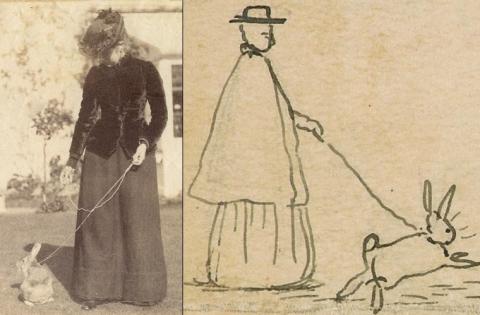
The original ideas for many of Beatrix Potter's stories can be found in the manuscript picture letters she wrote to children of friends and family members. Perhaps the most famous example is The Tale of Peter Rabbit, which began as an eight-page letter to Noel Moore, the five-year-old son of her former governess, Annie Moore. With Annie Moore's encouragement Potter borrowed back the letter, copied it out, and revised it for publication. At least six publishers rejected the book, but it was a huge success when the first trade edition finally appeared in 1902. The Tale of Squirrel Nutkin (1903), The Tale of Mr. Jeremy Fisher (1906), and other books in the Peter Rabbit series were based in whole or in part on her picture letters. In her opinion this was the secret of her success.
Her books retain the simple joy, subtle wit, and playful immediacy of impromptu private letters written for "real children" on subjects drawn from day-to-day experience with no commercial constraints and no thought of publication. Shown here are the twelve picture letters in the Morgan's collection. Eleven were addressed to Noel Moore, one to his younger sister Marjorie. Here one can see the earliest known picture letter along with later examples containing fanciful illustrations, comical vignettes, and narrative experiments that prefigure Peter Rabbit and other masterpieces of children's literature.
This online exhibition was created in conjunction with the exhibition Beatrix Potter: The Picture Letters, on view November 2, 2012, through January 27, 2013, organized by John Bidwell, Astor Curator of Printed Books and Bindings.
The exhibition is underwritten by Barbara and James Runde, and by Susan and Peter Solomon and Peter J. Solomon Company, L. P. Major funding is provided by Barbara Hanson Pierce, Michael Francis Hanson, and Robert Hixon Hanson in memory of their mother, Margaret Hixon Hanson. Further generous support is provided by The Caroline Macomber Fund, Rudy and Sara Ruggles, Justin G. Schiller, Ltd., and The Frelinghuysen Foundation.
![]() Sponsored by Penguin Group (USA) Inc.
Sponsored by Penguin Group (USA) Inc.
Left image credit: Cotsen Children's Library. Department of Rare Books and Special Collection. Princeton University Library
Thumbnails
March 11, 1892, page 1
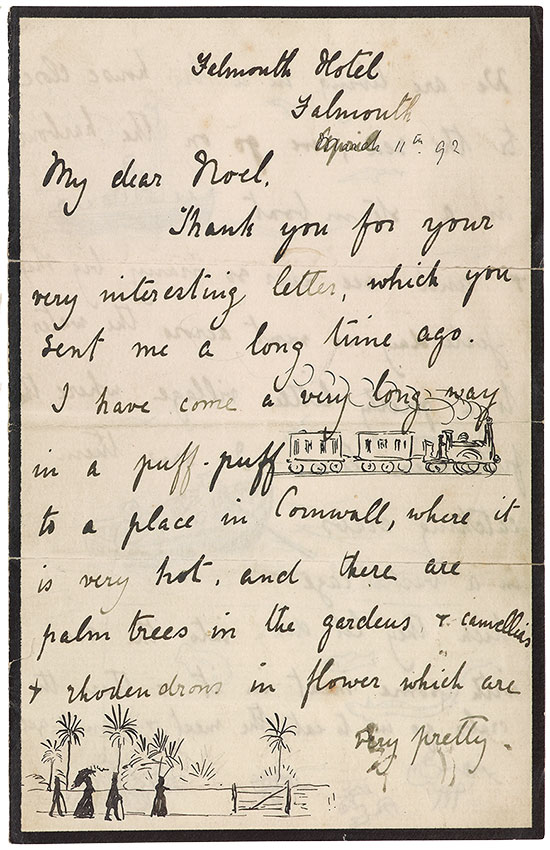
Autograph letter signed, Falmouth, to Noel Moore, March 11, 1892
Gift of Colonel David McC. McKell, 1959
This is Potter's earliest known picture letter, written to Noel Moore when he was four years old. It describes a holiday trip to a seaside resort in language easily understandable at his age with illustrations that might pique his interest and retain his attention. Note the passage in square brackets (at the bottom of the third page) cautioning his mother about seashells she proposed to give him and his younger brother.
My dear Noel,
Thank you for your very interesting letter, which you sent me a long time ago.
I have come a very long way in a puff-puff to a place in Cornwall, where it is very hot, and there are palm trees in the gardens & camellias and rho[de]dendrons in flower which are very pretty.
March 11, 1892, page 2–3
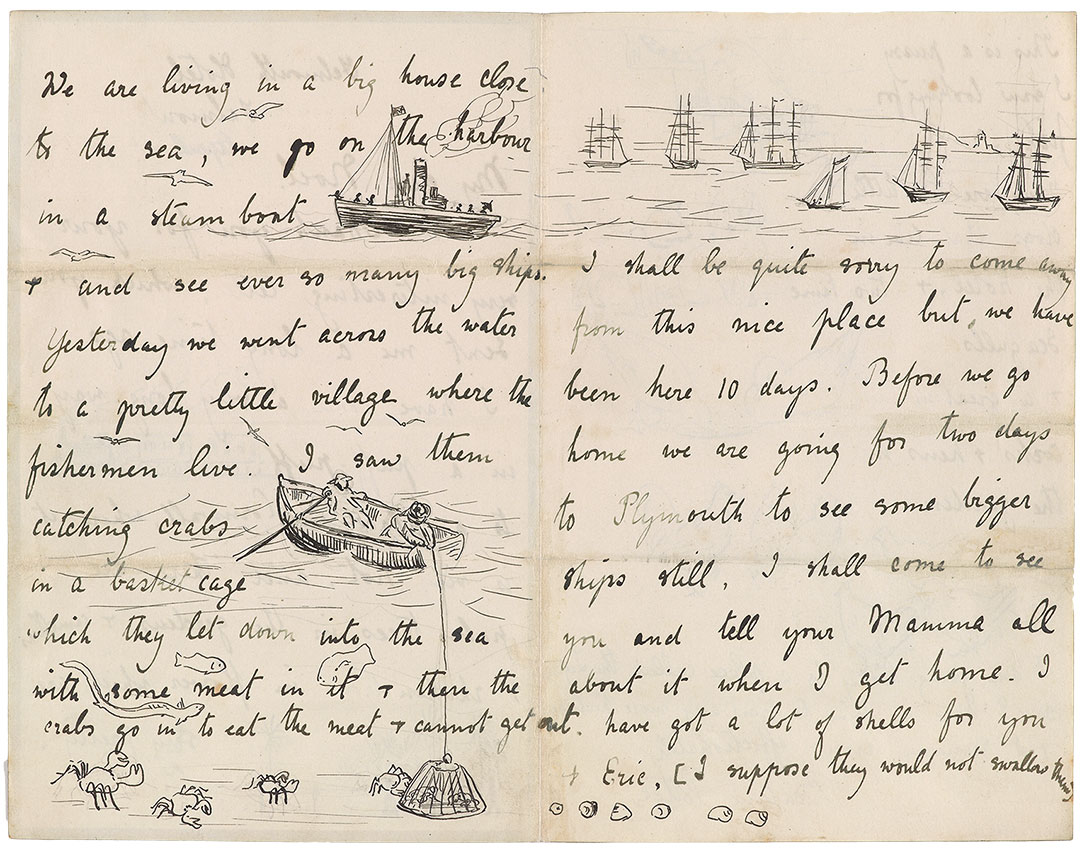
Autograph letter signed, Falmouth, to Noel Moore, March 11, 1892
Gift of Colonel David McC. McKell, 1959
This is Potter's earliest known picture letter, written to Noel Moore when he was four years old. It describes a holiday trip to a seaside resort in language easily understandable at his age with illustrations that might pique his interest and retain his attention. Note the passage in square brackets (at the bottom of the third page) cautioning his mother about seashells she proposed to give him and his younger brother.
We are living in a big house close to the sea, we go on the harbour in a steam boat and see ever so many big ships.
Yesterday we went across the water to a pretty little village where the fishermen live. I saw them catching crabs in a basket cage which they let down into the sea with some meat in it & then the crabs go in to eat the meat & cannot get out.
I shall be quite sorry to come away from this nice place but we have been here 10 days. Before we go home we are going for two days to Plymouth to see some bigger ships still. I shall come to see you and tell your Mamma all about it when I get home. I have got a lot of shells for you & Eric, [I suppose they would not swallow them]
March 11, 1892, page 4
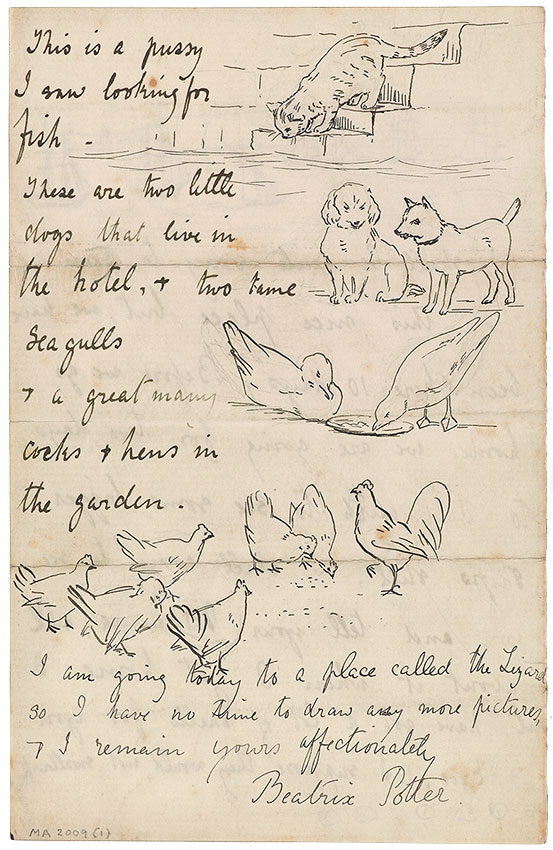
Autograph letter signed, Falmouth, to Noel Moore, March 11, 1892
Gift of Colonel David McC. McKell, 1959
This is Potter's earliest known picture letter, written to Noel Moore when he was four years old. It describes a holiday trip to a seaside resort in language easily understandable at his age with illustrations that might pique his interest and retain his attention. Note the passage in square brackets (at the bottom of the third page) cautioning his mother about seashells she proposed to give him and his younger brother.
This is a pussy I saw looking for fish.
These are two little dogs that live in the hotel, & two tame seagulls & a great many cocks & hens in the garden.
I am going today to a place called the Lizard so I have no time to draw any more pictures,
& I remain yours affectionately
Beatrix Potter
February 4, 1895, page 1
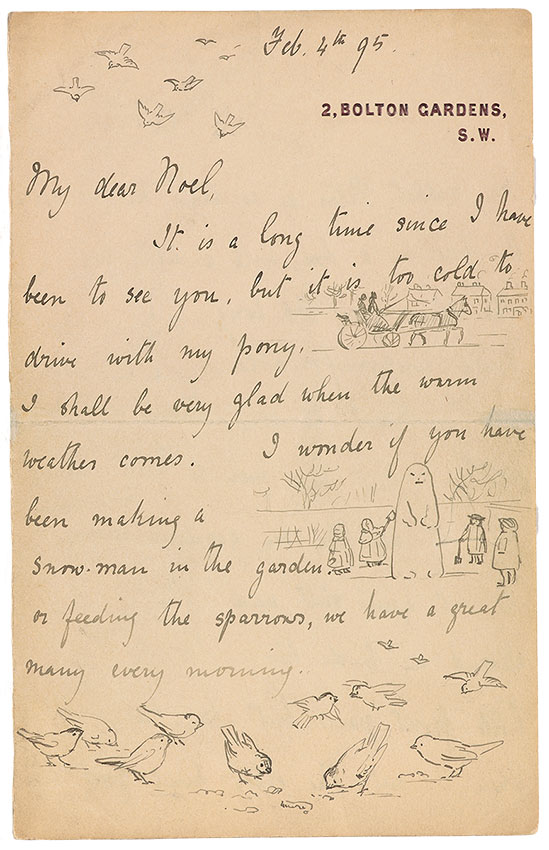
utograph letter signed, London, to Noel Moore, February 4, 1895
Gift of Colonel David McC. McKell, 1959
In this letter Potter touches on several topics including the winter weather, a pet cat, and the latest antics of Peter Rabbit. She wrote several letters to children with references to Peter and made at least three drawings of him asleep before the fire. She bought Peter in 1892, taught him tricks, took him on summer vacations, sketched him in a multitude of poses, and mourned his loss when he died in 1901: "whatever the limitations of his intellect or outward shortcomings of his fur, and his ears and toes, his disposition was uniformly amiable and his temper unfailingly sweet. An affectionate companion and a quiet friend."
My dear Noel,
It is a long time since I have been to see you, but it is too cold to drive with my pony. I shall be very glad when the warm weather comes. I wonder if you have been making a snow-man in the garden? or feeding the sparrows, we have a great many every morning.
February 4, 1895, page 2–3
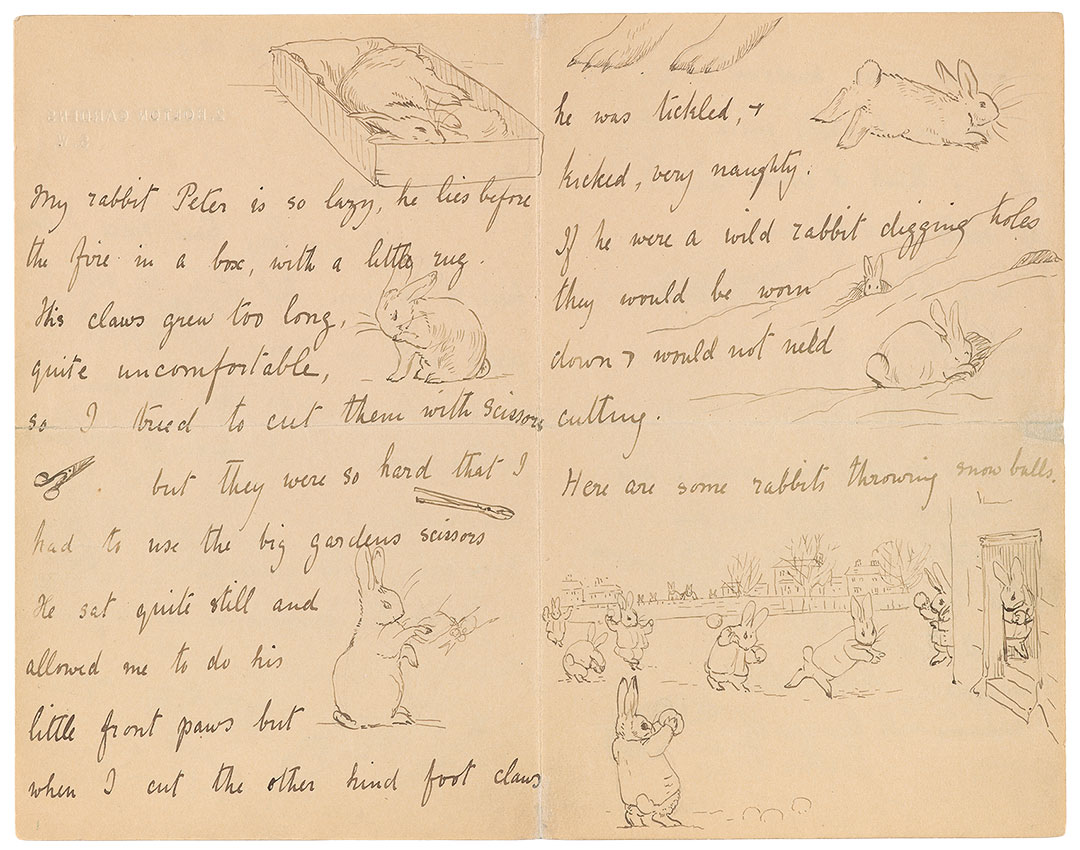
utograph letter signed, London, to Noel Moore, February 4, 1895
Gift of Colonel David McC. McKell, 1959
In this letter Potter touches on several topics including the winter weather, a pet cat, and the latest antics of Peter Rabbit. She wrote several letters to children with references to Peter and made at least three drawings of him asleep before the fire. She bought Peter in 1892, taught him tricks, took him on summer vacations, sketched him in a multitude of poses, and mourned his loss when he died in 1901: "whatever the limitations of his intellect or outward shortcomings of his fur, and his ears and toes, his disposition was uniformly amiable and his temper unfailingly sweet. An affectionate companion and a quiet friend."
My rabbit Peter is so lazy, he lies before the fire in a box, with a little rug. His claws grew too long, quite uncomfortable, so I tried to cut them with scissors but they were so hard that I had to use the big gardens scissors. He sat quite still and allowed me to do his little front paws but when I cut the other hind foot claws he was tickled, & kicked, very naughty. If he were a wild rabbit digging holes they would be worn down & would not need cutting.
Here are some rabbits throwing snow balls.
February 4, 1895, page 4
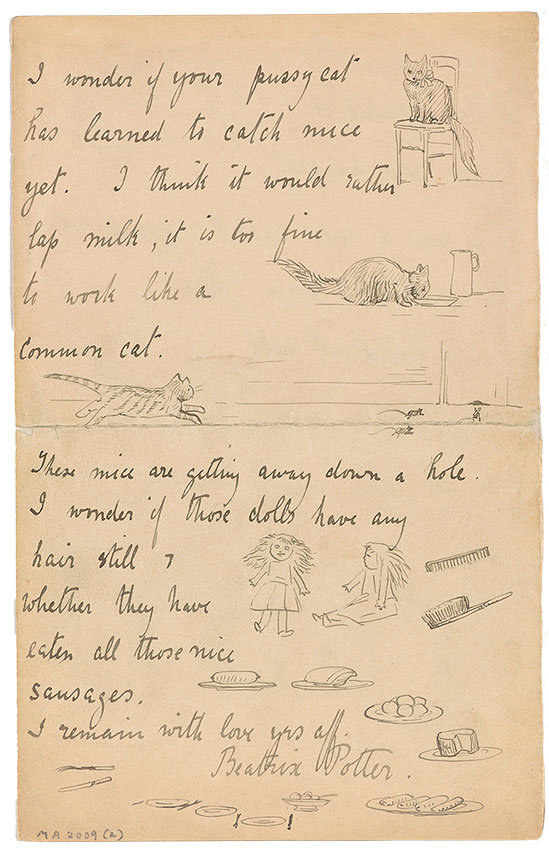
utograph letter signed, London, to Noel Moore, February 4, 1895
Gift of Colonel David McC. McKell, 1959
In this letter Potter touches on several topics including the winter weather, a pet cat, and the latest antics of Peter Rabbit. She wrote several letters to children with references to Peter and made at least three drawings of him asleep before the fire. She bought Peter in 1892, taught him tricks, took him on summer vacations, sketched him in a multitude of poses, and mourned his loss when he died in 1901: "whatever the limitations of his intellect or outward shortcomings of his fur, and his ears and toes, his disposition was uniformly amiable and his temper unfailingly sweet. An affectionate companion and a quiet friend."
I wonder if your pussycat has learned to catch mice yet. I think it would rather lap milk, it is too fine to work like a common cat.
These mice are getting away down a hole.
I wonder if those dolls have any hair still & whether they have eaten all those nice sausages.
I remain with love yrs aff.
Beatrix Potter
March 8, 1895, page 1
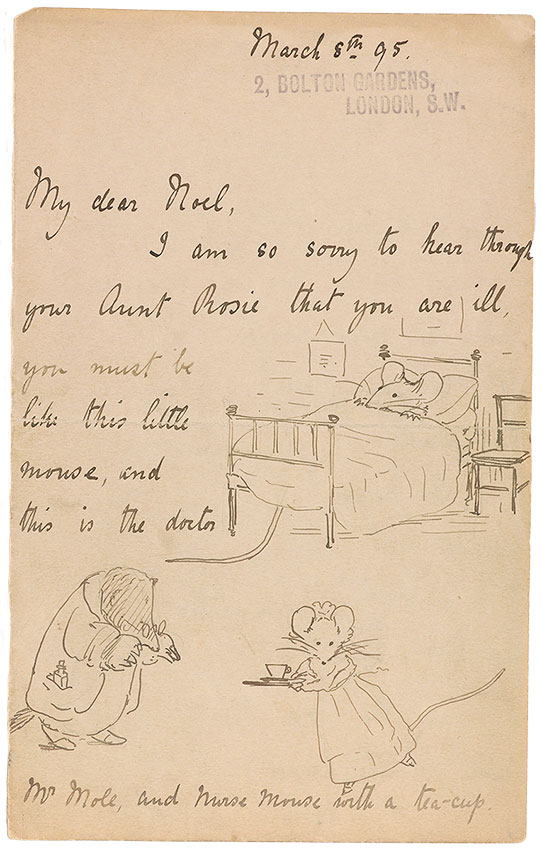
Autograph letter signed, London, to Noel Moore, March 8, 1895
Gift of Colonel David McC. McKell, 1959
This is the first of several get-well letters Potter wrote to Noel Moore while he was sick in bed during the spring of 1895. Her stories about a visit to the zoo were designed to raise the spirits of a child who might hope for similar adventures when his health improved. Instead of the usual cheery admonitions, she devised an amusing fantasy where the patient is attended by a solicitous mole physician and a sprightly mouse nurse bearing a tea-cup on a tray. She liked the image of the light-footed lady mouse and adapted it in Appley Dapply's Nursery Rhymes (1917), where the title character is shown scampering off with a platter full of pies.
My dear Noel,
I am so sorry to hear through your Aunt Rosie that you are ill, you must be like this little mouse, and this is the doctor Mr. Mole, and Nurse Mouse with a tea-cup.
March 8, 1895, page 2–3
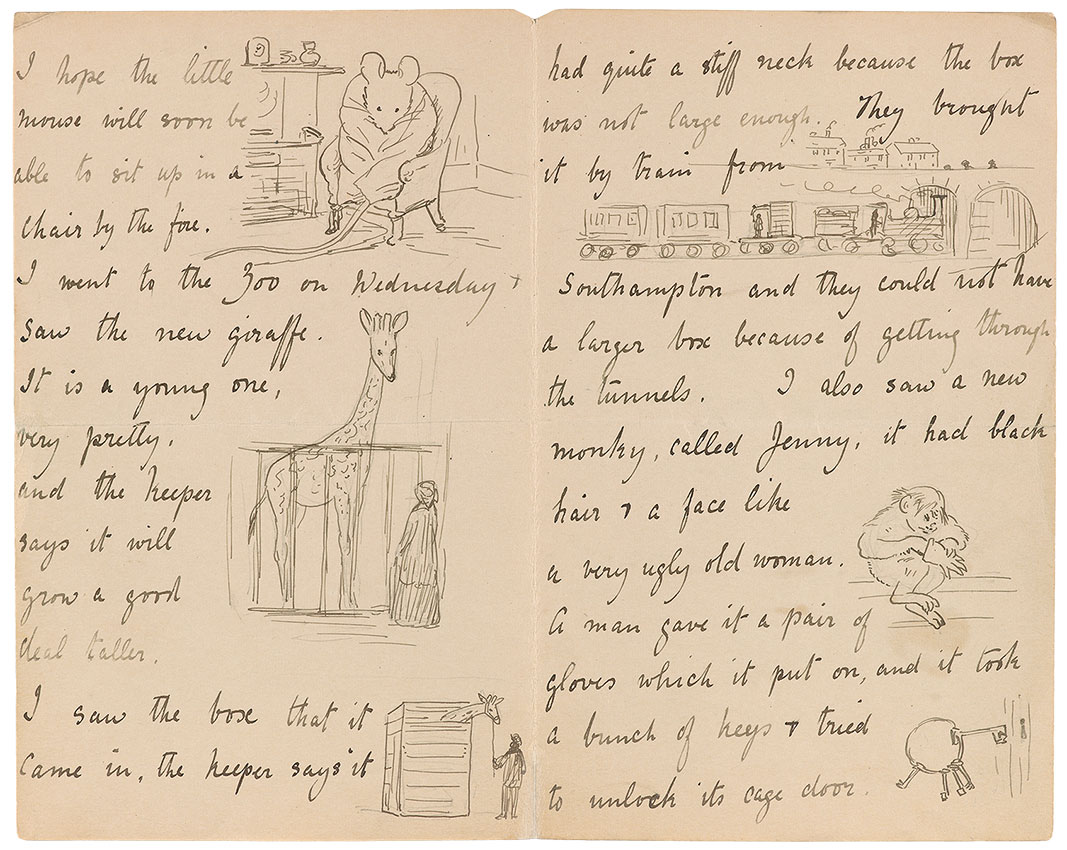
Autograph letter signed, London, to Noel Moore, March 8, 1895
Gift of Colonel David McC. McKell, 1959
This is the first of several get-well letters Potter wrote to Noel Moore while he was sick in bed during the spring of 1895. Her stories about a visit to the zoo were designed to raise the spirits of a child who might hope for similar adventures when his health improved. Instead of the usual cheery admonitions, she devised an amusing fantasy where the patient is attended by a solicitous mole physician and a sprightly mouse nurse bearing a tea-cup on a tray. She liked the image of the light-footed lady mouse and adapted it in Appley Dapply's Nursery Rhymes (1917), where the title character is shown scampering off with a platter full of pies.
I hope the little mouse will soon be able to sit up in a chair by the fire.
I went to the zoo on Wednesday & saw the new giraffe. It is a young one, very pretty, and the keeper says it will grow a good deal taller.
I saw the box that it came in, the keeper says it had quite a stiff neck because the box was not large enough. They brought it by train from Southampton and they could not have a larger box because of getting through the tunnels. I also saw anew monk[e]y, called Jenny, it had black hair & a face like a very ugly old woman. A man gave it a pair of gloves which it put on, and it took a bunch of keys & tried to unlock its cage door.
March 8, 1895, page 4
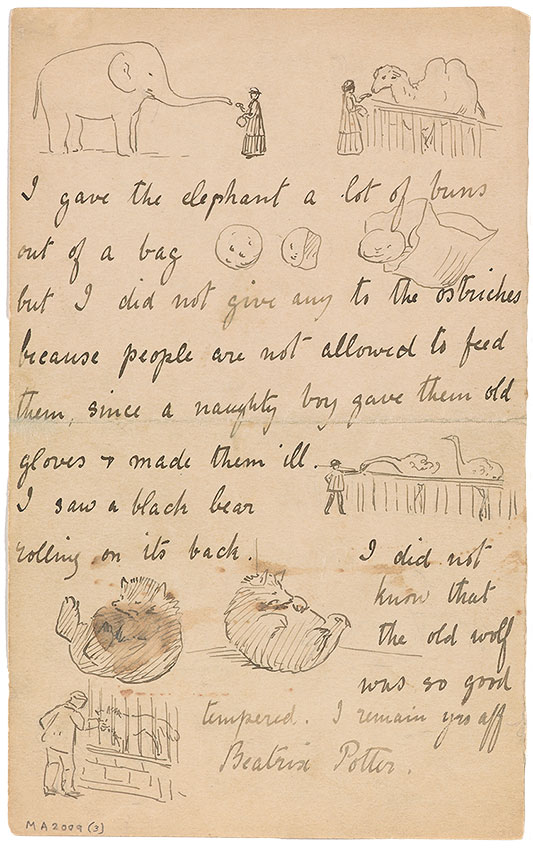
Autograph letter signed, London, to Noel Moore, March 8, 1895
Gift of Colonel David McC. McKell, 1959
This is the first of several get-well letters Potter wrote to Noel Moore while he was sick in bed during the spring of 1895. Her stories about a visit to the zoo were designed to raise the spirits of a child who might hope for similar adventures when his health improved. Instead of the usual cheery admonitions, she devised an amusing fantasy where the patient is attended by a solicitous mole physician and a sprightly mouse nurse bearing a tea-cup on a tray. She liked the image of the light-footed lady mouse and adapted it in Appley Dapply's Nursery Rhymes (1917), where the title character is shown scampering off with a platter full of pies.
I gave the elephant a lot of buns out of a bag but I did not give any to the ostriches because people are not allowed to feed them, since a naughty boy gave them old gloves & made them ill. I saw a black bear rolling on its back. I did not know that the old wolf was so good tempered.
I remain yrs aff
Beatrix Potter
June 4, 1895, page 1
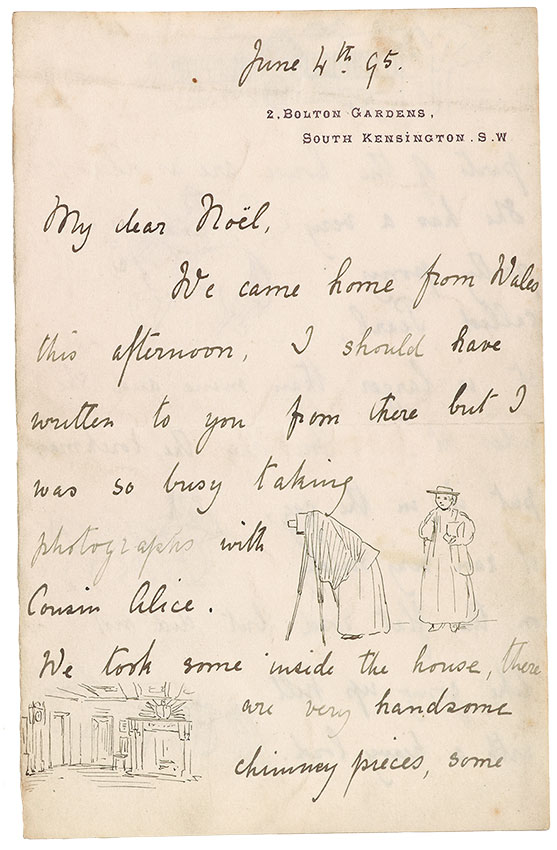
Autograph letter signed, London, to Noel Moore, June 4, 1895
Gift of Colonel David McC. McKell, 1959
Potter sent Noel a series of letters with anecdotes about animals she had seen in her travels. Here she reports on a trip to Wales, where she observed the curious conduct of donkeys, dogs, and a pony. Although she was appealing to Noel's interests, she also reveals her likes and dislikes: a life-long passion for antiques and fine old houses as well as a distinct lack of sympathy for a Welsh village she had visited.
My dear Noël,
We came home from Wales this afternoon. I should have written to you from there but I was so busy taking photographs with Cousin Alice. We took some inside the house, there are very handsome chimney pieces, some
June 4, 1895, page 2–3
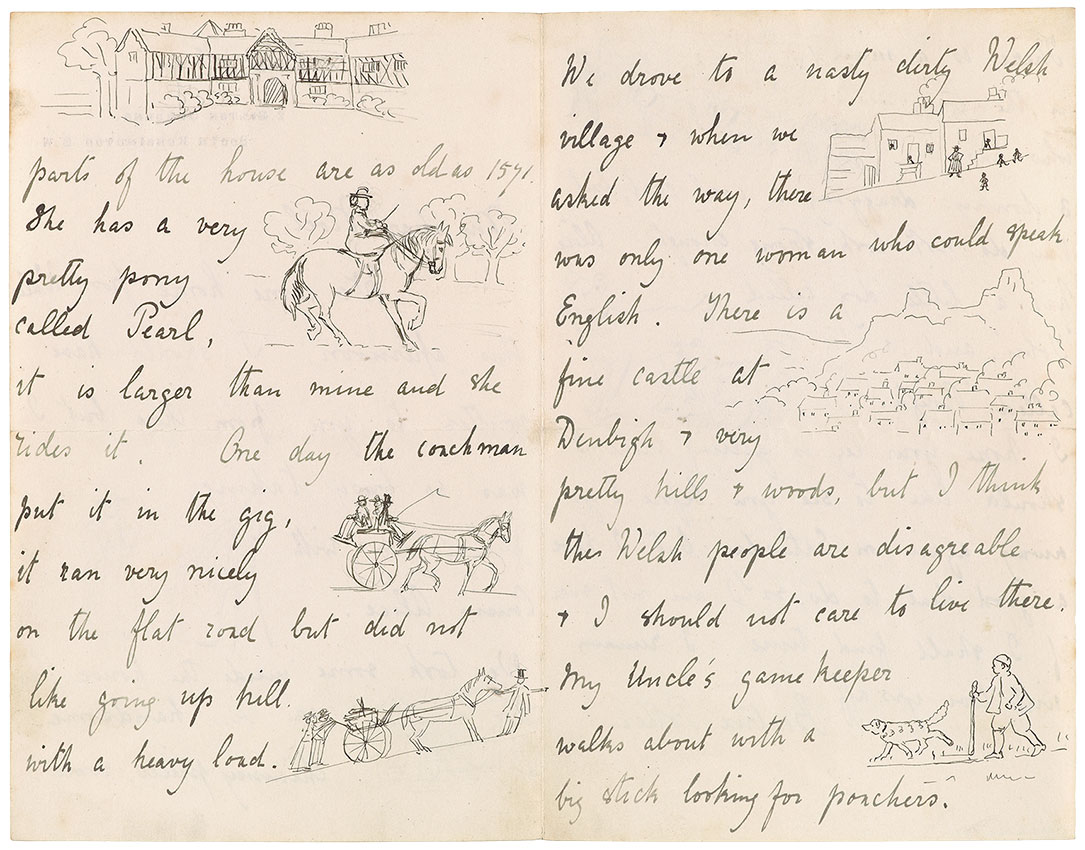
Autograph letter signed, London, to Noel Moore, June 4, 1895
Gift of Colonel David McC. McKell, 1959
Potter sent Noel a series of letters with anecdotes about animals she had seen in her travels. Here she reports on a trip to Wales, where she observed the curious conduct of donkeys, dogs, and a pony. Although she was appealing to Noel's interests, she also reveals her likes and dislikes: a life-long passion for antiques and fine old houses as well as a distinct lack of sympathy for a Welsh village she had visited.
parts of the house are as old as 1571.
She has a very pretty pony called Pearl, it is larger than mine and she rides it. One day the coachman put it in the gig, it ran very nicely on the flat road but did not like going up hill with a heavy load.
We drove to a nasty dirty Welsh village & when we asked the way, there was only one woman who could speak English. There is a fine castle at Denbigh & very pretty hills & woods, but I think the Welsh people are disagre[e]able & I should not care to live there. My Uncle's game keeper walks about with a big stick looking for poachers.
June 4, 1895, page 4
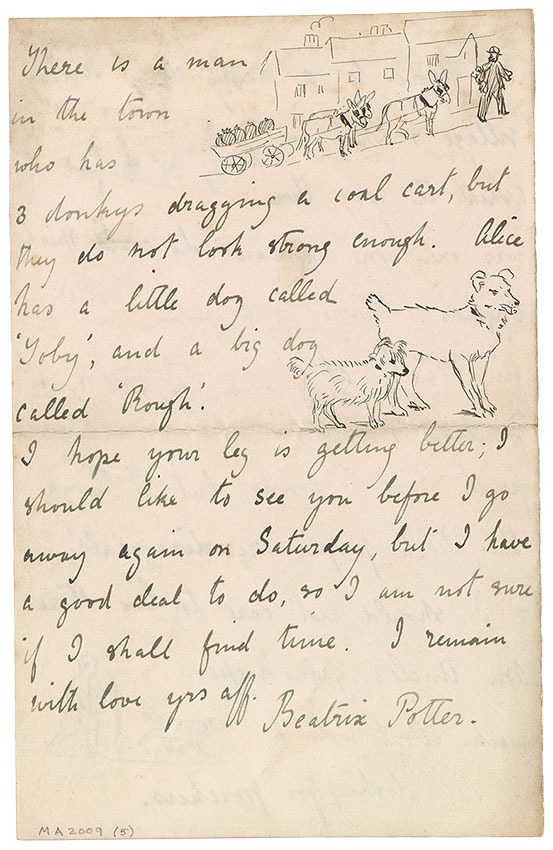
Autograph letter signed, London, to Noel Moore, June 4, 1895
Gift of Colonel David McC. McKell, 1959
Potter sent Noel a series of letters with anecdotes about animals she had seen in her travels. Here she reports on a trip to Wales, where she observed the curious conduct of donkeys, dogs, and a pony. Although she was appealing to Noel's interests, she also reveals her likes and dislikes: a life-long passion for antiques and fine old houses as well as a distinct lack of sympathy for a Welsh village she had visited.
There is a man in the town who has 3 donk[e]ys dragging a coal cart, but they do not look strong enough. Alice has a little dog called 'Toby', and a big dog called 'Rough'.
I hope your leg is getting better; I should like to see you before I go away again on Saturday, but I have a good deal to do, so I am not sure if I shall find time. I remain with love yrs aff
Beatrix Potter
September 3, 1895, page 1
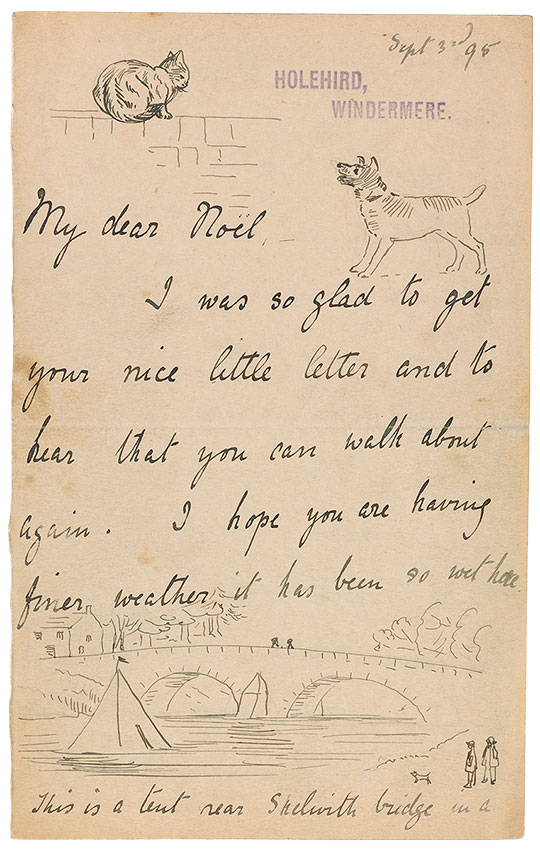
Autograph letter signed, Windermere, to Noel Moore, September 3, 1895
Gift of Colonel David McC. McKell, 1959
This letter contains two self-caricatures. One shows Potter contemplating the awful prospect of a ladder she would have to climb to view a roost of pigeons. In the other she is walking a rambunctious Peter Rabbit on a leash. An earlier letter to Noel contains a sketch of Peter's predecessor, Benjamin Bouncer, on a similar outing with a collar and a lead. She often sketched herself in her letters for humorous effect and included two notional self-portraits in her books, one in The Roly-Poly Pudding and another in The Tale of Pigling Bland.
My dear Noël,
I was so glad to get your nice little letter and to hear that you can walk about again. I hope you are having finer weather, it has been so wet here.
This is a tent near Skelwith bridge in a
September 3, 1895, page 2–3
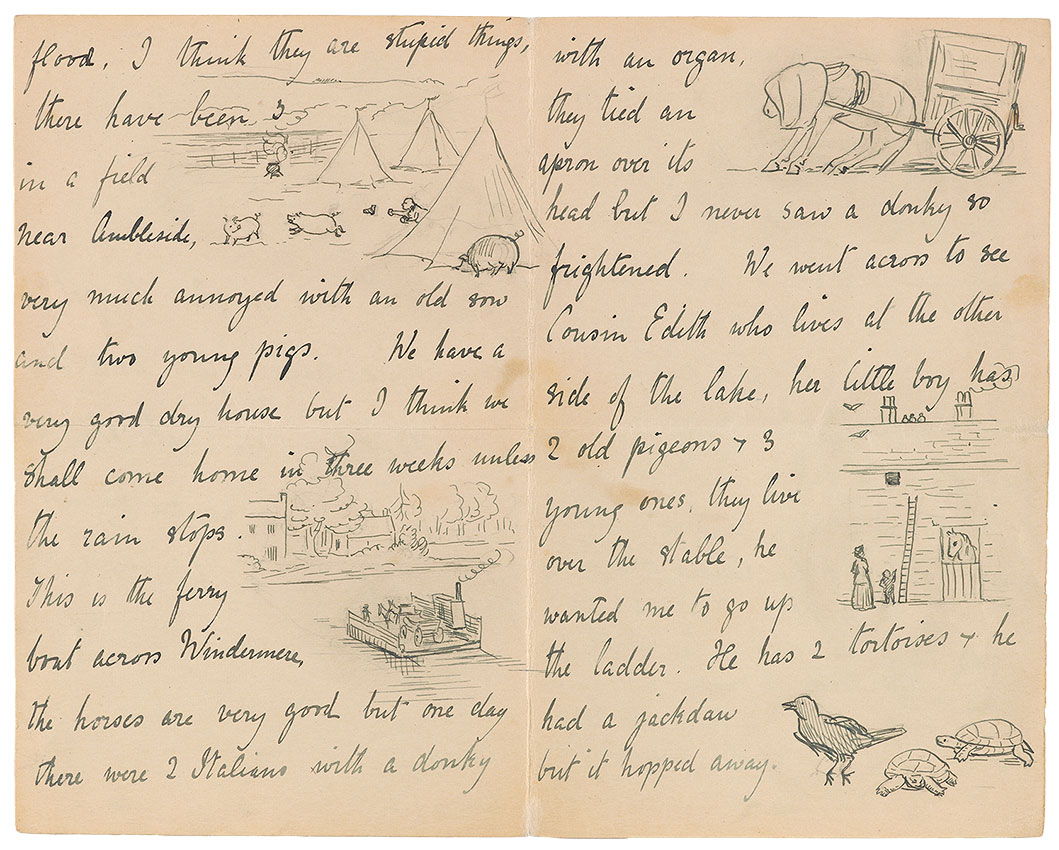
Autograph letter signed, Windermere, to Noel Moore, September 3, 1895
Gift of Colonel David McC. McKell, 1959
This letter contains two self-caricatures. One shows Potter contemplating the awful prospect of a ladder she would have to climb to view a roost of pigeons. In the other she is walking a rambunctious Peter Rabbit on a leash. An earlier letter to Noel contains a sketch of Peter's predecessor, Benjamin Bouncer, on a similar outing with a collar and a lead. She often sketched herself in her letters for humorous effect and included two notional self-portraits in her books, one in The Roly-Poly Pudding and another in The Tale of Pigling Bland.
flood. I think they are stupid things, there have been 3 in a field near Ambleside, very much annoyed with an old sow and two young pigs. We have a very good dry house but I think we shall come home in three weeks unless the rain stops.
This is the ferry boat across Windermere, the horses are very good but one day there were 2 Italians with a donk[e]y with an organ, they tied an apron over its head but I never saw a donk[e]y so frightened. We went across to see Cousin Edith who lives at the other side of the lake, her little boy has 2 old pigeons & 3 young ones, they live over the stable, he wanted me to go up the ladder. He has 2 tortoises & he had a jackdaw but it happed away.
September 3, 1895, page 4
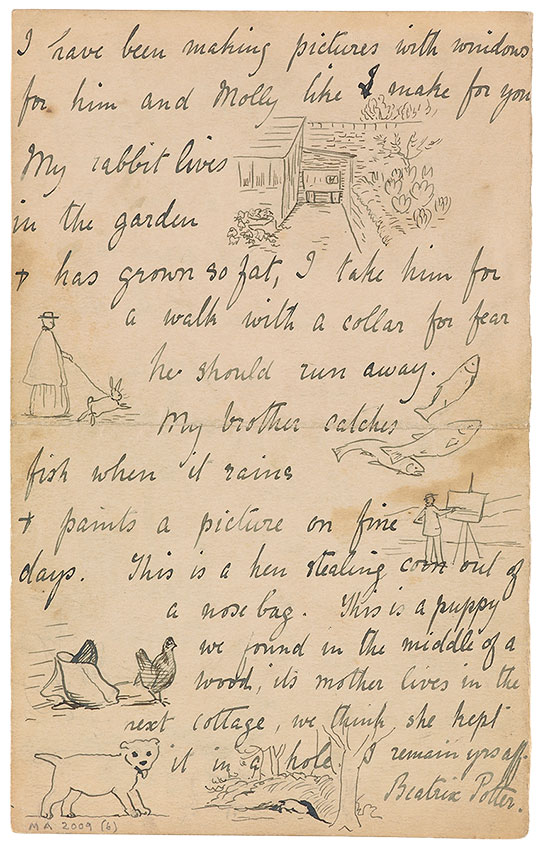
Autograph letter signed, Windermere, to Noel Moore, September 3, 1895
Gift of Colonel David McC. McKell, 1959
This letter contains two self-caricatures. One shows Potter contemplating the awful prospect of a ladder she would have to climb to view a roost of pigeons. In the other she is walking a rambunctious Peter Rabbit on a leash. An earlier letter to Noel contains a sketch of Peter's predecessor, Benjamin Bouncer, on a similar outing with a collar and a lead. She often sketched herself in her letters for humorous effect and included two notional self-portraits in her books, one in The Roly-Poly Pudding and another in The Tale of Pigling Bland.
I have been making pictures with windows for him and Molly like I make for you.
My rabbit lives in the garden & has grown so fat, I take him for a walk with a collar for fear he should run away.
My brother catches fish when it rains & paints a picture on fine days. This is a hen stealing corn out of a bag. This is a puppy we found in the middle of a wood, its mother lives in the next cottage, we think she kept it in a hole.
I remain yrs aff.
Beatrix Potter
April 6, 1896, page 1
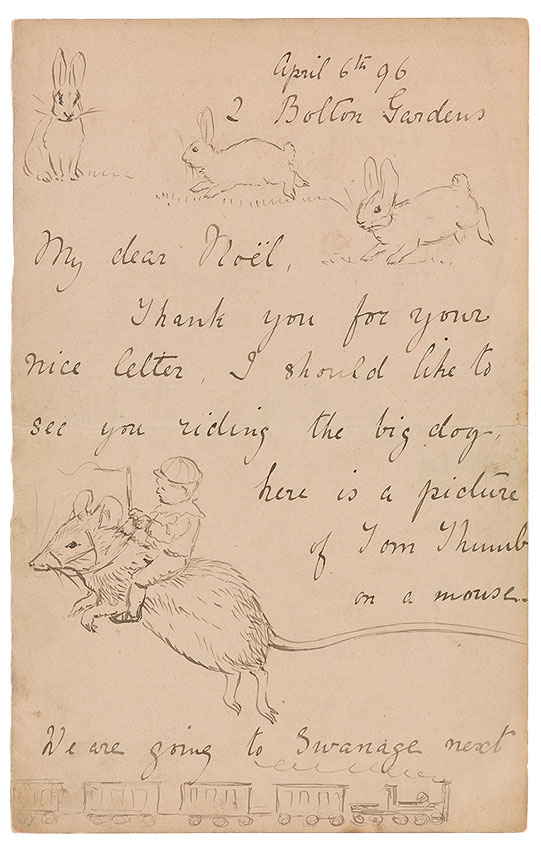
Autograph letter signed, London, to Noel Moore, April 6, 1896
Gift of Colonel David McC. McKell, 1959
Once again Potter writes to Noel about a trip to the zoo, an opportunity to draw exotic animals in addition to familiar creatures such as the rabbits gamboling at the head of the letter and the sparrows nesting at the end. As much as Potter loved her pets, she was also remarkably unsentimental about animals, both as a naturalist who studied them from a scientific point of view and as a farmer who tended livestock for sale and home consumption. The death of the elephant was regrettable but also occasioned a comic drawing of the valetudinarian about to receive a jumbo dose of medicine. The mother sparrow lamenting the loss of her baby is a parody of grief.
My dear Noël,
Thank you for your nice letter. I should like to see you riding the big dog, here is a picture of Tom Thumb on a mouse.
We are going to Swanage next
April 6, 1896, page 2–3
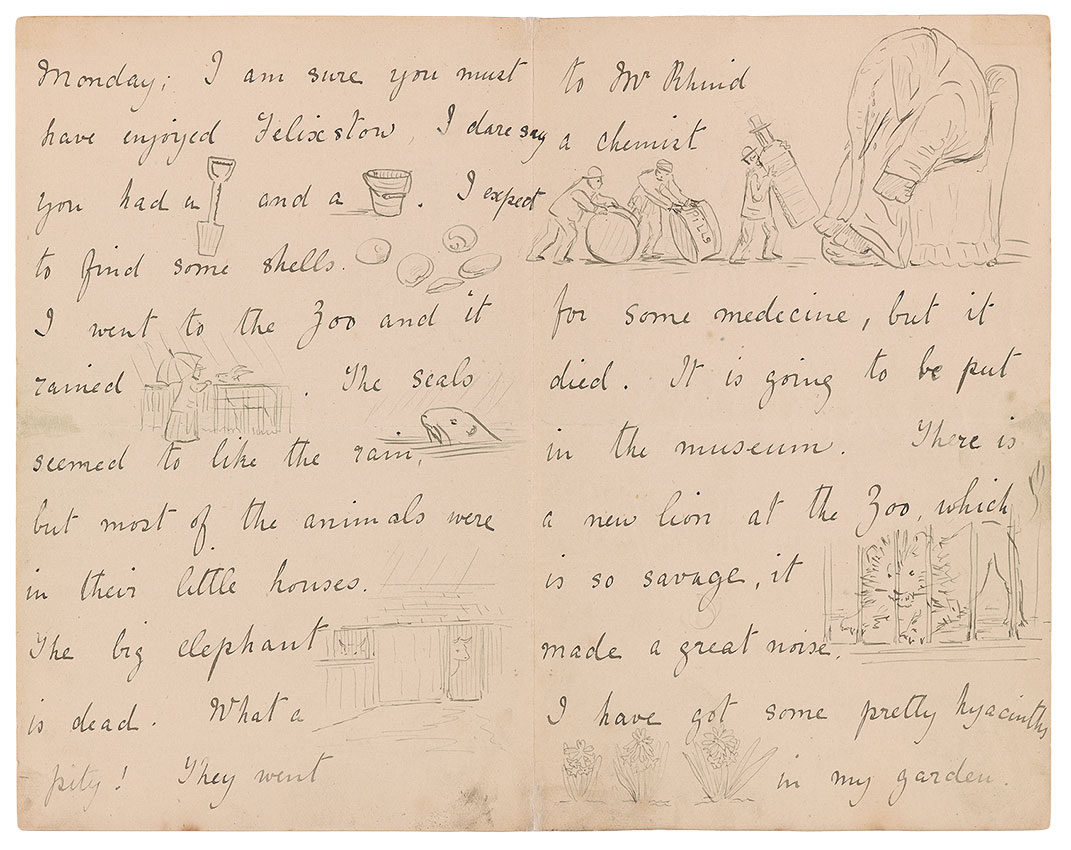
Autograph letter signed, London, to Noel Moore, April 6, 1896
Gift of Colonel David McC. McKell, 1959
Once again Potter writes to Noel about a trip to the zoo, an opportunity to draw exotic animals in addition to familiar creatures such as the rabbits gamboling at the head of the letter and the sparrows nesting at the end. As much as Potter loved her pets, she was also remarkably unsentimental about animals, both as a naturalist who studied them from a scientific point of view and as a farmer who tended livestock for sale and home consumption. The death of the elephant was regrettable but also occasioned a comic drawing of the valetudinarian about to receive a jumbo dose of medicine. The mother sparrow lamenting the loss of her baby is a parody of grief.
Monday; I am sure you must have enjoyed Felixstow[e], I dare say you had a [spade] and a [bucket]. I expect to find some shells.
I went to the zoo and it rained. The seals seemed to like the rain, but most of the animals were in their little houses. The big elephant is dead. What a pity! They went to Mr Rhind a chemist for some medicine, but it died. It is going to be put in the museum. There is a new lion at the zoo, which is so savage, it made a great noise.
I have got some pretty hyacinths in my garden.
April 6, 1896, page 4
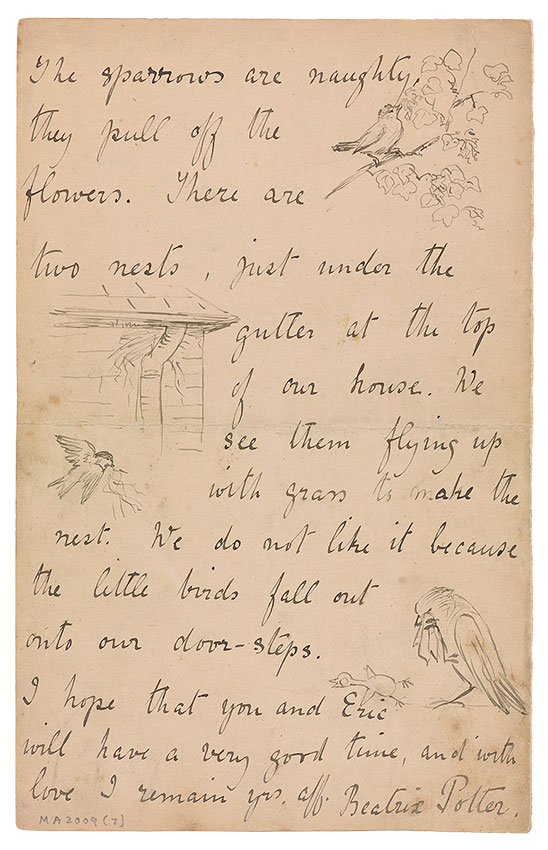
Autograph letter signed, London, to Noel Moore, April 6, 1896
Gift of Colonel David McC. McKell, 1959
Once again Potter writes to Noel about a trip to the zoo, an opportunity to draw exotic animals in addition to familiar creatures such as the rabbits gamboling at the head of the letter and the sparrows nesting at the end. As much as Potter loved her pets, she was also remarkably unsentimental about animals, both as a naturalist who studied them from a scientific point of view and as a farmer who tended livestock for sale and home consumption. The death of the elephant was regrettable but also occasioned a comic drawing of the valetudinarian about to receive a jumbo dose of medicine. The mother sparrow lamenting the loss of her baby is a parody of grief.
The sparrows are naughty, they pull off the flowers. There are two nests, just under the gutter at the top of our house. We see them flying up with grass to make the nest. We do not like it because the little birds fall out onto our door-steps.
I hope that you and Eric will have a very good time,
and with love I remain yrs aff
Beatrix Potter
August 7, 1896, page 1
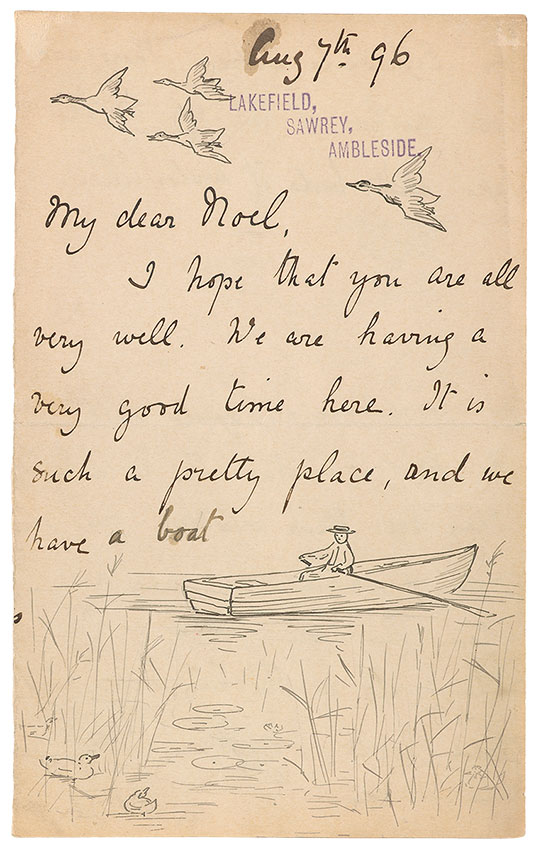
Autograph letter signed, Ambleside, to Noel Moore, August 7, 1896
Gift of Colonel David McC. McKell, 1959
The Lake District in northwest England was a vacation spot favored by the Potter family, especially Beatrix, who eventually settled in the vicinity. Here are some of her first impressions of this picturesque locale. She frequently sketched the marshland scenery around Esthwaite Water, which probably inspired parts of The Tale of Mr. Jeremy Fisher. Other picture letters contain the rudiments of that story, in which Jeremy embarks on his fishing adventures by rowing out on a river, an idea prompted by holiday excursions along the River Tay in Scotland. In the published version, however, Jeremy flirts with danger while floating on a lily pad like those depicted in this letter. Potter's experiences on Esthwaite Water may have convinced her that a tranquil pond would be a better setting for an afternoon idyll on the water, the mood broken only briefly by delightfully absurd, nearly fatal developments in a deceptively simple plot.
My dear Noël,
I hope that you are all very well. We are having a very good time here. It is such a pretty place, and we have a boat
August 7, 1896, page 2–3
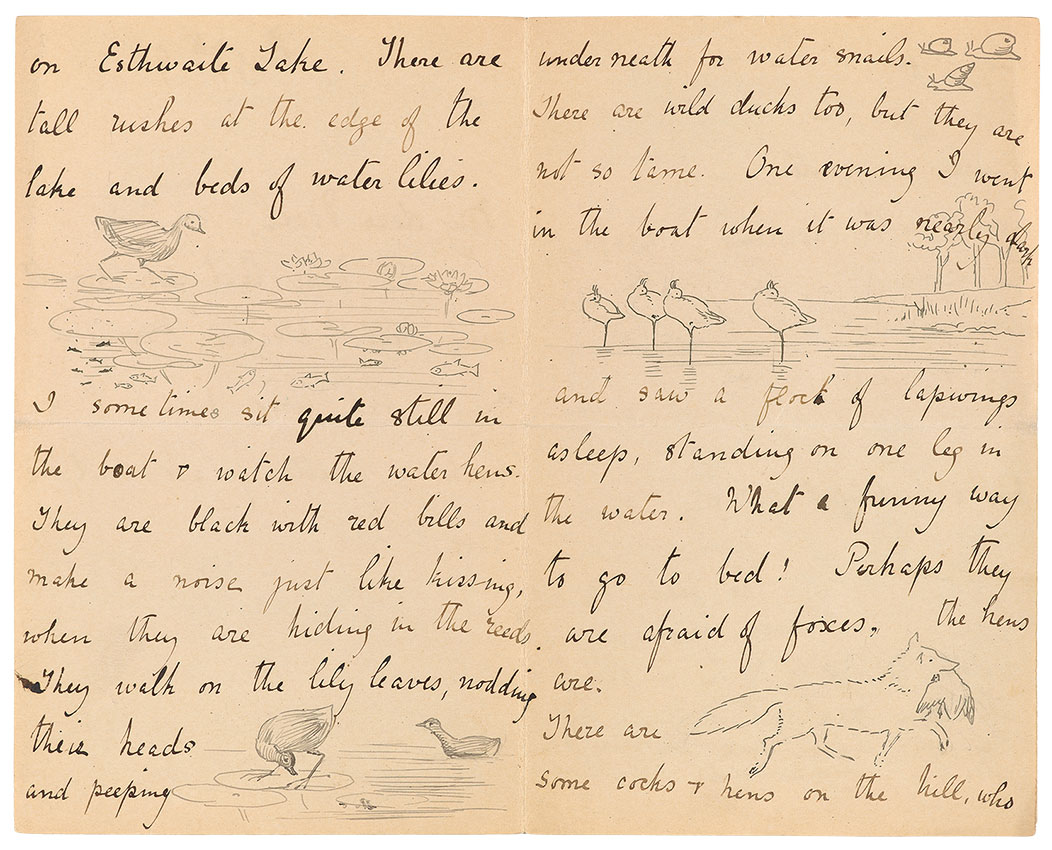
Autograph letter signed, Ambleside, to Noel Moore, August 7, 1896
Gift of Colonel David McC. McKell, 1959
The Lake District in northwest England was a vacation spot favored by the Potter family, especially Beatrix, who eventually settled in the vicinity. Here are some of her first impressions of this picturesque locale. She frequently sketched the marshland scenery around Esthwaite Water, which probably inspired parts of The Tale of Mr. Jeremy Fisher. Other picture letters contain the rudiments of that story, in which Jeremy embarks on his fishing adventures by rowing out on a river, an idea prompted by holiday excursions along the River Tay in Scotland. In the published version, however, Jeremy flirts with danger while floating on a lily pad like those depicted in this letter. Potter's experiences on Esthwaite Water may have convinced her that a tranquil pond would be a better setting for an afternoon idyll on the water, the mood broken only briefly by delightfully absurd, nearly fatal developments in a deceptively simple plot.
on Esthwaite Lake. There are tall rushes at the edge of the lake and beds of water lilies.
I sometimes sit quite still in the boat & watch the water hens. They are black with red bills and make a noise just like kissing, when they are hiding in the reeds. They walk on the lily leaves, nodding their heads and peeping underneath for water snails. There are wild ducks too, but they are not so tame. One evening I went in the boat when it was nearly dark and saw a flock of lapwings asleep, standing on one leg in the water. What a funny way to go to bed! Perhaps they are afraid of foxes, the hens are.
There are some cocks & hens on the hill, who
August 7, 1896, page 4
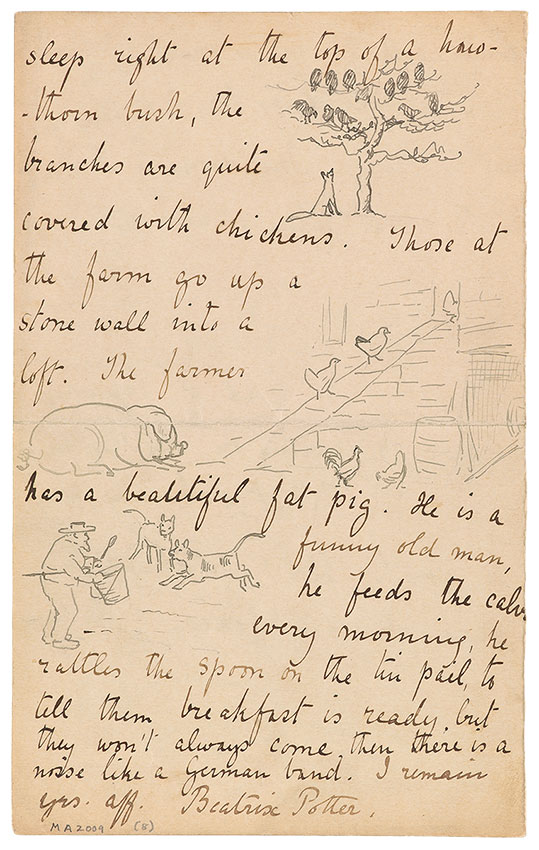
Autograph letter signed, Ambleside, to Noel Moore, August 7, 1896
Gift of Colonel David McC. McKell, 1959
The Lake District in northwest England was a vacation spot favored by the Potter family, especially Beatrix, who eventually settled in the vicinity. Here are some of her first impressions of this picturesque locale. She frequently sketched the marshland scenery around Esthwaite Water, which probably inspired parts of The Tale of Mr. Jeremy Fisher. Other picture letters contain the rudiments of that story, in which Jeremy embarks on his fishing adventures by rowing out on a river, an idea prompted by holiday excursions along the River Tay in Scotland. In the published version, however, Jeremy flirts with danger while floating on a lily pad like those depicted in this letter. Potter's experiences on Esthwaite Water may have convinced her that a tranquil pond would be a better setting for an afternoon idyll on the water, the mood broken only briefly by delightfully absurd, nearly fatal developments in a deceptively simple plot.
sleep right at the top of a hawthorn bush, the branches are quite covered with chickens. Those at the farm go up a stone wall into a loft. The farmer has a beautiful fat pig. He is a funny old man, he feeds the calves every morning, he rattles the spoon on the tin pail, to tell them breakfast is ready, but they won't always come, then there is a noise like a German band.
I remain yrs. aff.
Beatrix Potter
February 27, 1897, page 1
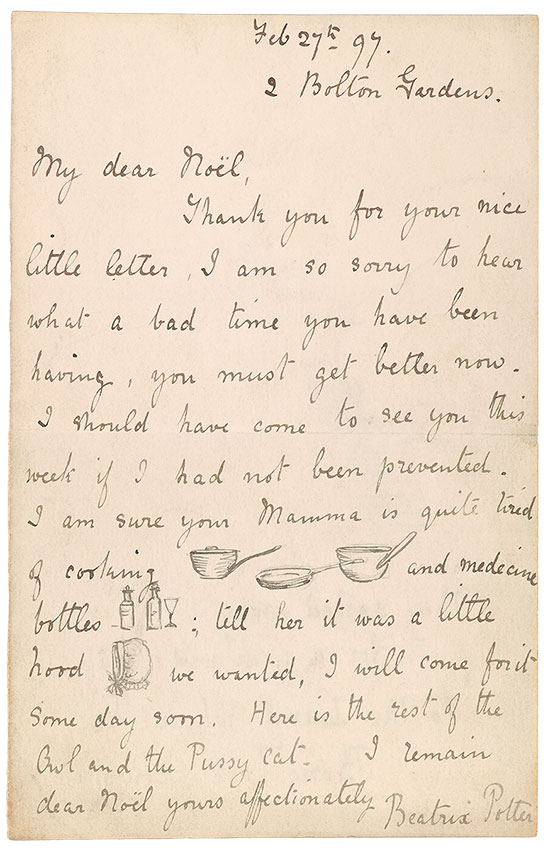
Autograph letter signed, London, to Noel Moore, February 27, 1897
Gift of Colonel David McC. McKell, 1959
Potter adored Edward Lear's nonsense rhymes and particularly this prime example, which she first saw at age four and a half in a copy of Lear's Nonsense Songs, a Christmas present from her father. She retold the story of the Owl and the Pussy-Cat with her own illustrations in two letters to Noel Moore—this one and another in the collection of the Cotsen Children's Library at Princeton University. They contain an abridged version of Lear's text but a larger selection of pictures, some based on Lear, others invented by Potter.
It was during a holiday visit to Falmouth harbor that Potter glimpsed a pig on board a ship and wondered what its fate might be on a sea voyage ("when the sailors get hungry they eat it"). In the picture letter in the Cotsen Collection she imagined how it might escape in the ship's dinghy and go off to live on an island like Robinson Crusoe. Even better, she succeeded in linking one children's classic with another by supposing that the escapee might row off to safety in the island "where the Bong-tree grows" and become the "Piggy-wig" who assisted in the nuptials of the Owl and the Pussy-Cat.
Potter would later turn the pig-on-board theme into a book, The Tale of Little Pig Robinson (1930).
My dear Noël,
Thank you for your nice little letter, I am so sorry to hear what a bad time you have been having, you must get better now. I should have come to see you this week if I had not been prevented. I am sure your Mamma is quite tired of cooking and medecine [sic] bottles; tell her it was a little hood we wanted, I will come for it some day soon. Here is the rest of the Owl and the Pussy cat.
I remain dear Noël yours affectionately
Beatrix Potter
February 27, 1897, page 2–3
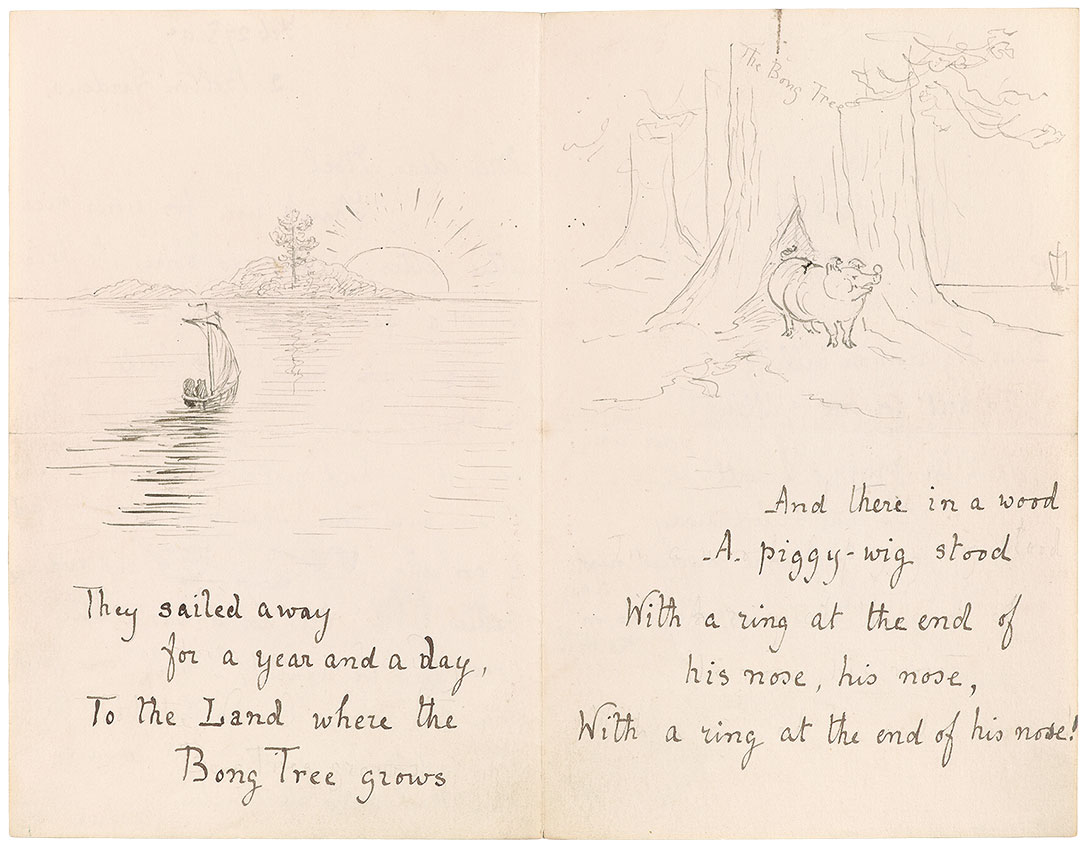
Autograph letter signed, London, to Noel Moore, February 27, 1897
Gift of Colonel David McC. McKell, 1959
Potter adored Edward Lear's nonsense rhymes and particularly this prime example, which she first saw at age four and a half in a copy of Lear's Nonsense Songs, a Christmas present from her father. She retold the story of the Owl and the Pussy-Cat with her own illustrations in two letters to Noel Moore—this one and another in the collection of the Cotsen Children's Library at Princeton University. They contain an abridged version of Lear's text but a larger selection of pictures, some based on Lear, others invented by Potter.
It was during a holiday visit to Falmouth harbor that Potter glimpsed a pig on board a ship and wondered what its fate might be on a sea voyage ("when the sailors get hungry they eat it"). In the picture letter in the Cotsen Collection she imagined how it might escape in the ship's dinghy and go off to live on an island like Robinson Crusoe. Even better, she succeeded in linking one children's classic with another by supposing that the escapee might row off to safety in the island "where the Bong-tree grows" and become the "Piggy-wig" who assisted in the nuptials of the Owl and the Pussy-Cat.
Potter would later turn the pig-on-board theme into a book, The Tale of Little Pig Robinson (1930).
They sailed away
for a year and a day,
To the Land where the
Bong Tree grows
And there in a wood
A piggy-wig stood
With a ring at the end of
his nose, his nose
With a ring at the end of his nose!
February 27, 1897, page 4
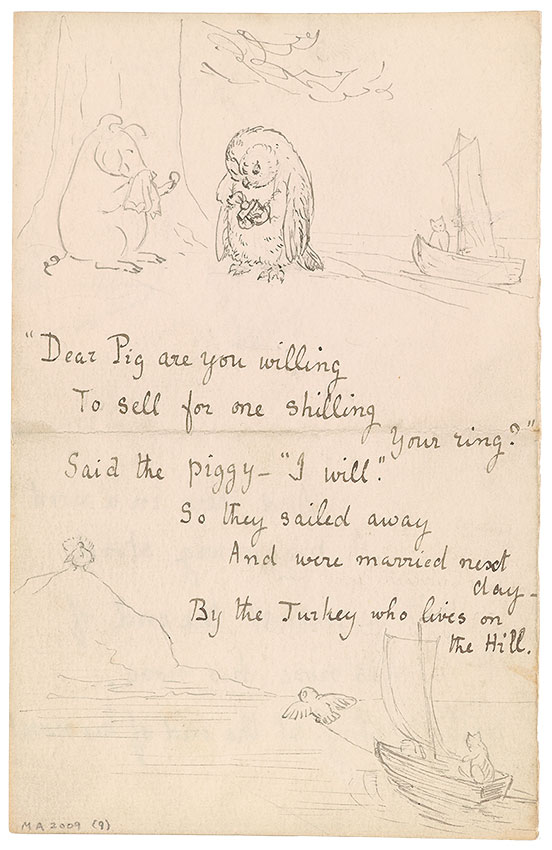
Autograph letter signed, London, to Noel Moore, February 27, 1897
Gift of Colonel David McC. McKell, 1959
Potter adored Edward Lear's nonsense rhymes and particularly this prime example, which she first saw at age four and a half in a copy of Lear's Nonsense Songs, a Christmas present from her father. She retold the story of the Owl and the Pussy-Cat with her own illustrations in two letters to Noel Moore—this one and another in the collection of the Cotsen Children's Library at Princeton University. They contain an abridged version of Lear's text but a larger selection of pictures, some based on Lear, others invented by Potter.
It was during a holiday visit to Falmouth harbor that Potter glimpsed a pig on board a ship and wondered what its fate might be on a sea voyage ("when the sailors get hungry they eat it"). In the picture letter in the Cotsen Collection she imagined how it might escape in the ship's dinghy and go off to live on an island like Robinson Crusoe. Even better, she succeeded in linking one children's classic with another by supposing that the escapee might row off to safety in the island "where the Bong-tree grows" and become the "Piggy-wig" who assisted in the nuptials of the Owl and the Pussy-Cat.
Potter would later turn the pig-on-board theme into a book, The Tale of Little Pig Robinson (1930).
"Dear Pig are you willing
To sell for one shilling
your ring?"
Said the piggy—"I will".
So they sailed away
And were married next day
By the Turkey who lives on the Hill.
March 4, 1897, page 1
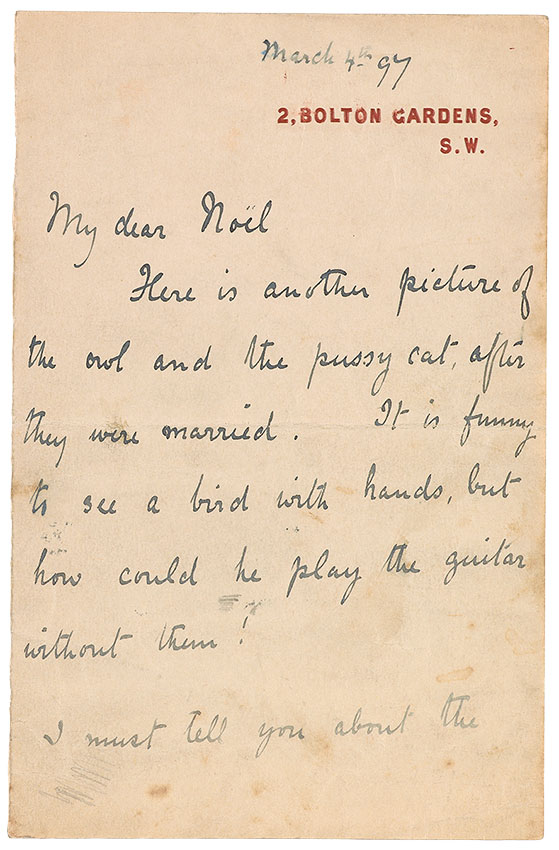
Autograph letter signed, London, to Noel Moore, March 4, 1897
Gift of Colonel David McC. McKell, 1959
Following up on the previous letter, Potter wrote again to Noel Moore about the Owl and the Pussy-Cat, this time with a sequel showing an idyllic portrait of the married couple. The owl sips honey spoon in hand while the cat fishes for dinner. This scene required an explanation: "It is funny to see a bird with hands, but how could he play the guitar without them?" Logical conundrums like this were part of the pleasure she took in the nonsense verse of Edward Lear. In these letters she paid tribute to Lear and perfected the story-telling skills she would employ in her own publications.
My dear Noël
Here is another picture of the owl and the pussy cat, after they were married. It is funny to see a bird with hands, but how could he play the guitar without them?
I must tell you about the
March 4, 1897, page 2–3
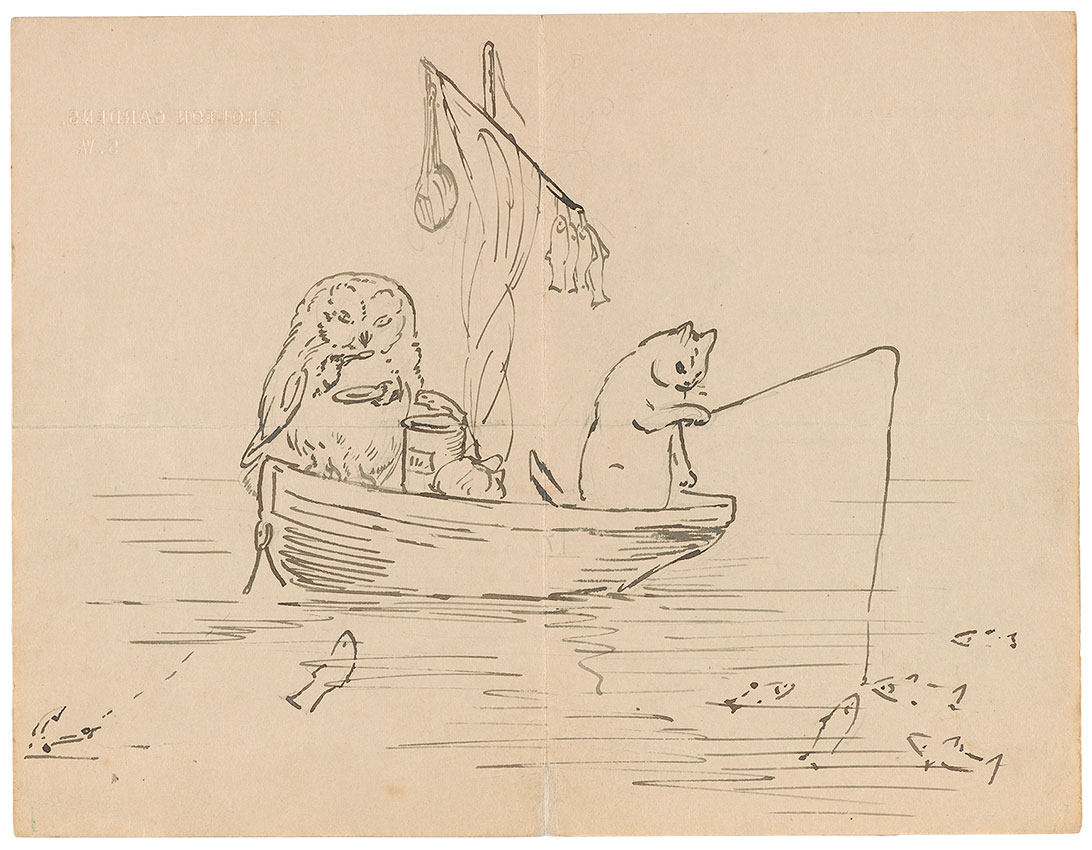
Autograph letter signed, London, to Noel Moore, March 4, 1897
Gift of Colonel David McC. McKell, 1959
Following up on the previous letter, Potter wrote again to Noel Moore about the Owl and the Pussy-Cat, this time with a sequel showing an idyllic portrait of the married couple. The owl sips honey spoon in hand while the cat fishes for dinner. This scene required an explanation: "It is funny to see a bird with hands, but how could he play the guitar without them?" Logical conundrums like this were part of the pleasure she took in the nonsense verse of Edward Lear. In these letters she paid tribute to Lear and perfected the story-telling skills she would employ in her own publications.
[Drawing of the Owl and the Pussycat]
March 4, 1897, page 4
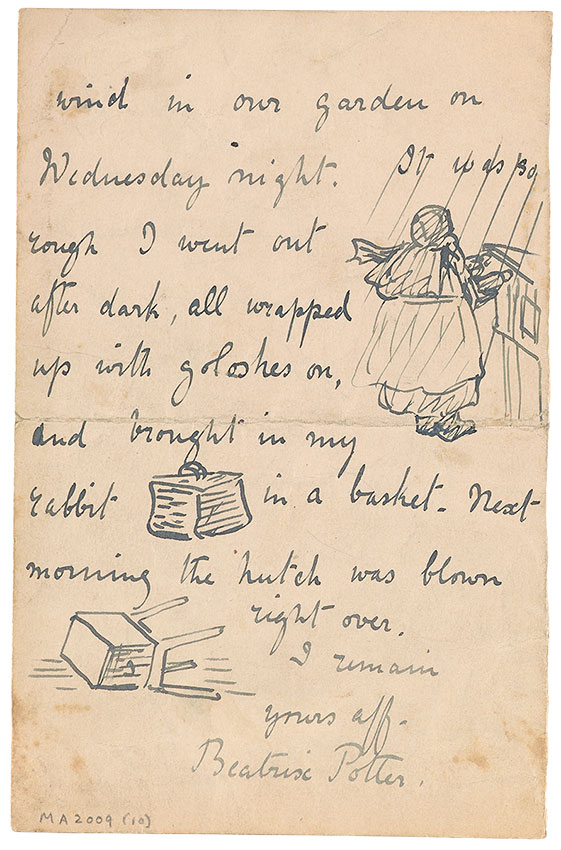
Autograph letter signed, London, to Noel Moore, March 4, 1897
Gift of Colonel David McC. McKell, 1959
Following up on the previous letter, Potter wrote again to Noel Moore about the Owl and the Pussy-Cat, this time with a sequel showing an idyllic portrait of the married couple. The owl sips honey spoon in hand while the cat fishes for dinner. This scene required an explanation: "It is funny to see a bird with hands, but how could he play the guitar without them?" Logical conundrums like this were part of the pleasure she took in the nonsense verse of Edward Lear. In these letters she paid tribute to Lear and perfected the story-telling skills she would employ in her own publications.
wind in our garden on Wednesday night. It was so rough I went out after dark, all wrapped up with galoshes on, and brought in my rabbit in a basket. Next morning the hutch was blown right over.
I remain yours aff.
Beatrix Potter
April 17, 1898, page 1
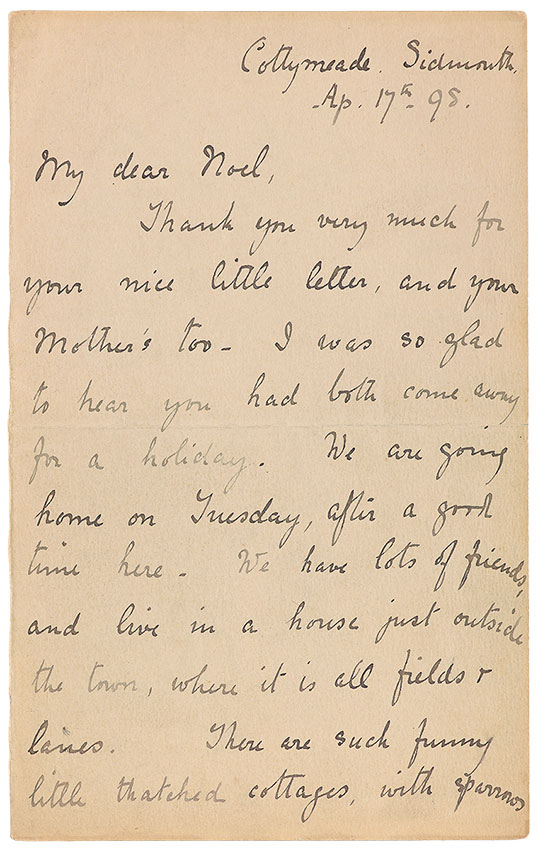
Autograph letter signed, Sidmouth, to Noel Moore, April 17, 1898
Gift of Colonel David McC. McKell, 1959
One of Potter's last publications, The Tale of Little Pig Robinson (1930), contains story ideas that first appeared in her picture letters of the 1890s. This picture letter is noteworthy for its fine illustrations and the curious account of the dog Stumpy, pensioned off for life by his grateful owner. Stumpy and his trust fund remained in the back of the mind of the author, who transcribed some details of the letter almost word-for-word in the published version.
My dear Noel,
Thank you very much for your nice little letter, and your Mother's too. I was so glad to hear you had both come away for a holiday. We are going home on Tuesday, after a good time here. We have lots of friends, and live in a house just outside the town, where it is all fields & lanes. There are such funny little thatched cottages, with sparrows
April 17, 1898, page 2–3
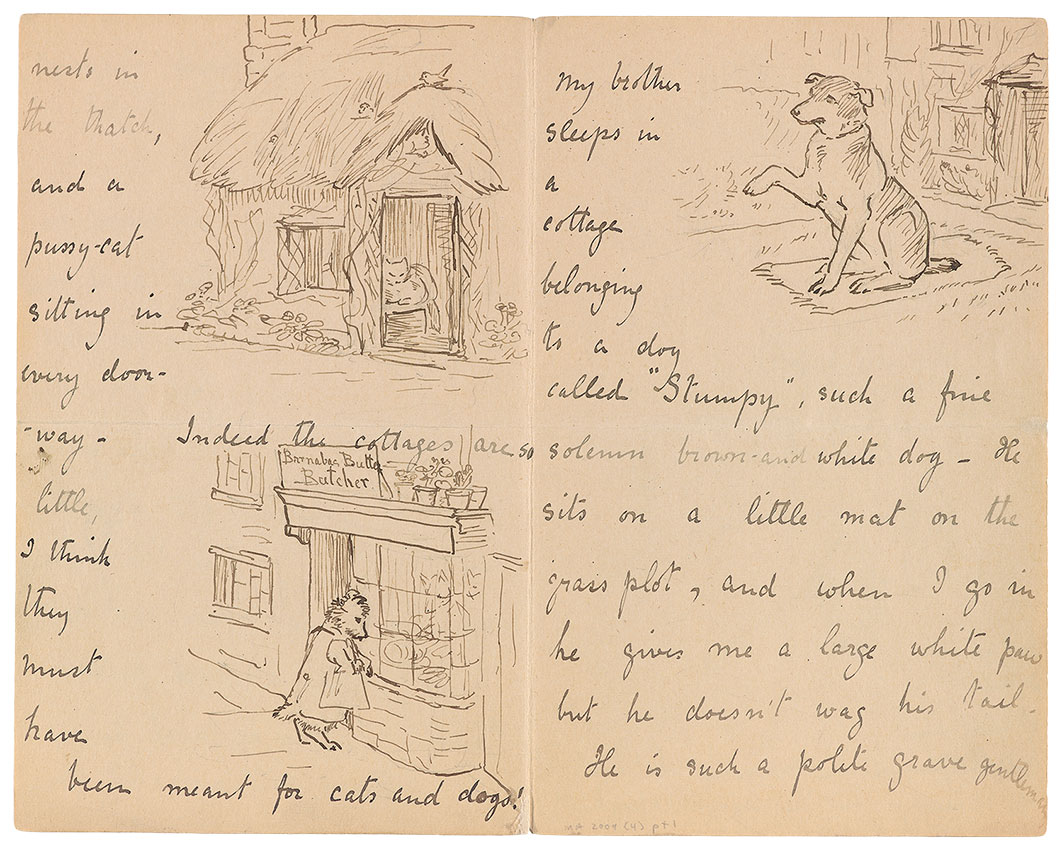
Autograph letter signed, Sidmouth, to Noel Moore, April 17, 1898
Gift of Colonel David McC. McKell, 1959
One of Potter's last publications, The Tale of Little Pig Robinson (1930), contains story ideas that first appeared in her picture letters of the 1890s. This picture letter is noteworthy for its fine illustrations and the curious account of the dog Stumpy, pensioned off for life by his grateful owner. Stumpy and his trust fund remained in the back of the mind of the author, who transcribed some details of the letter almost word-for-word in the published version.
nests in the thatch, and a pussy-cat sitting in every doorway. Indeed the cottages are so little, I think they must have been meant for cats and dogs!
My brother sleeps in a cottage belonging to a dog called "Stumpy", such a fine solemn brown-and white dog. He sits on a little mat on the grass plot, and when I go in he gives me a large white paw but he doesn't wag his tail. He is such a polite grave gentleman
April 17, 1898, page 4
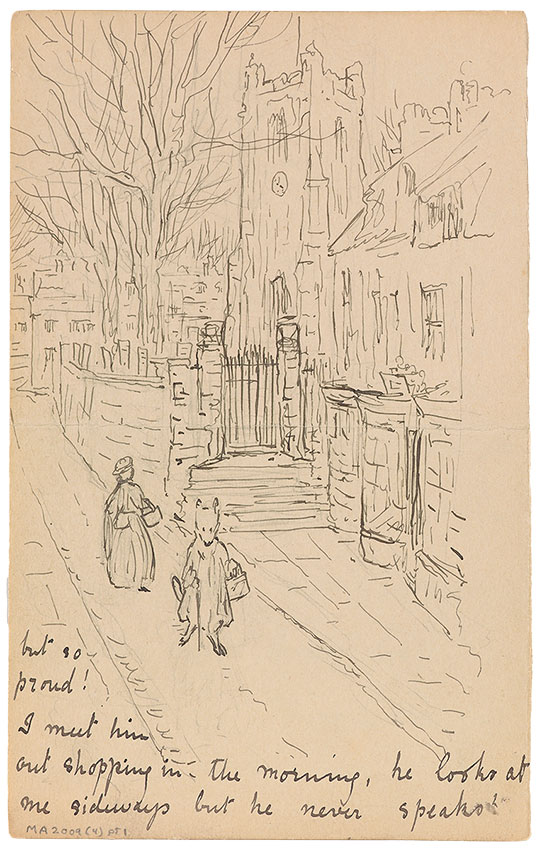
Autograph letter signed, Sidmouth, to Noel Moore, April 17, 1898
Gift of Colonel David McC. McKell, 1959
One of Potter's last publications, The Tale of Little Pig Robinson (1930), contains story ideas that first appeared in her picture letters of the 1890s. This picture letter is noteworthy for its fine illustrations and the curious account of the dog Stumpy, pensioned off for life by his grateful owner. Stumpy and his trust fund remained in the back of the mind of the author, who transcribed some details of the letter almost word-for-word in the published version.
but so proud! I meet him out shopping in the morning, he looks at me sideways but he never speaks!
April 17, 1898, page 5
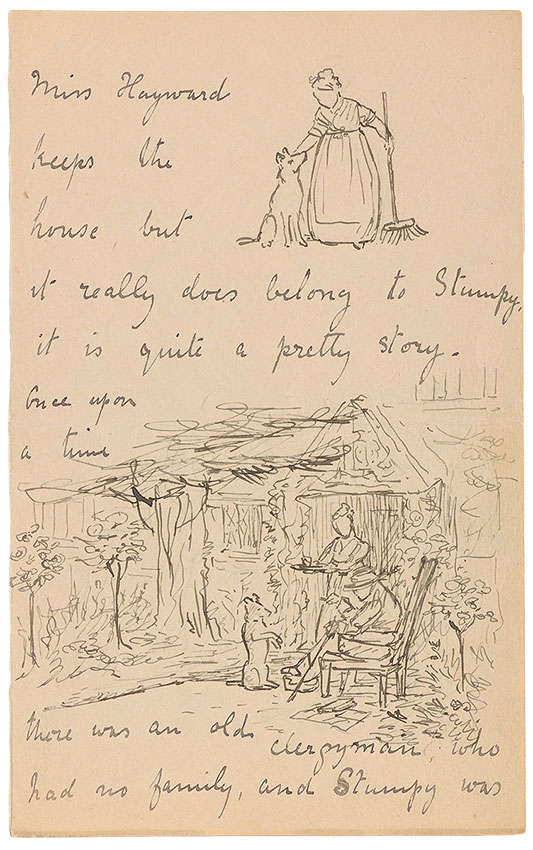
Autograph letter signed, Sidmouth, to Noel Moore, April 17, 1898
Gift of Colonel David McC. McKell, 1959
One of Potter's last publications, The Tale of Little Pig Robinson (1930), contains story ideas that first appeared in her picture letters of the 1890s.
Miss Hayward keeps the house, but it really does belong to Stumpy, it is quite a pretty story.
Once upon a time there was an old clergyman, who had no family, and Stumpy was
April 17, 1898, page 6–7
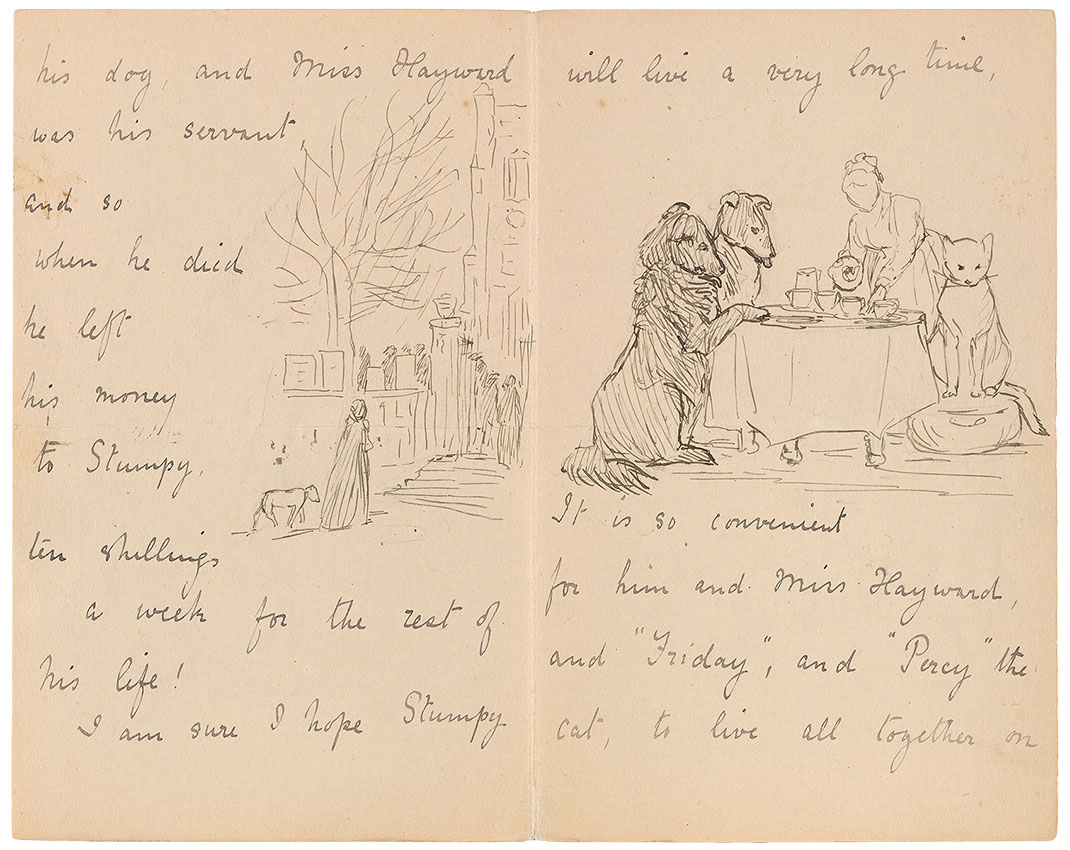
Autograph letter signed, Sidmouth, to Noel Moore, April 17, 1898
Gift of Colonel David McC. McKell, 1959
One of Potter's last publications, The Tale of Little Pig Robinson (1930), contains story ideas that first appeared in her picture letters of the 1890s.
his dog, and Miss Hayward was his servant, and so when he died he left his money to Stumpy, ten shillings a week for the rest of his life!
I am sure I hope Stumpy will live a very long time. It is so convenient for him and Miss Hayward, and "Friday", and "Percy" the cat, to live all together on
April 17, 1898, page 8
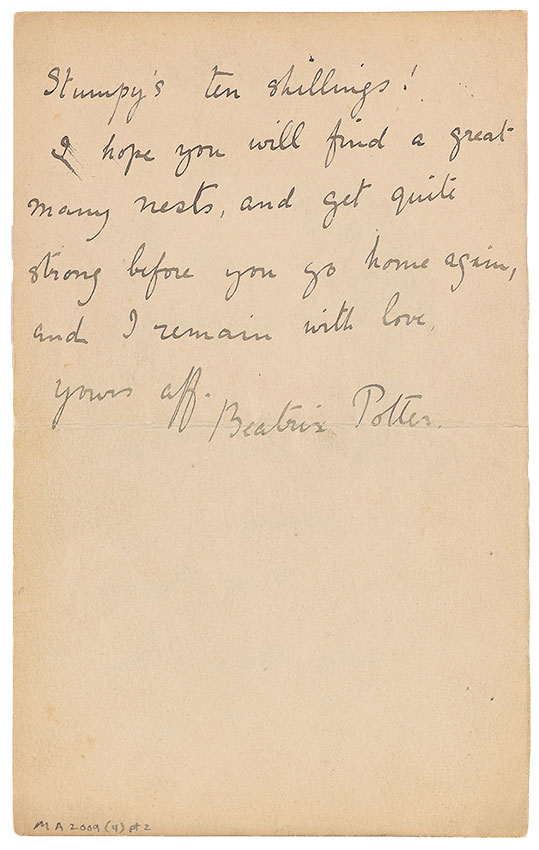
Autograph letter signed, Sidmouth, to Noel Moore, April 17, 1898
Gift of Colonel David McC. McKell, 1959
One of Potter's last publications, The Tale of Little Pig Robinson (1930), contains story ideas that first appeared in her picture letters of the 1890s.
Stumpy's ten shillings!
I hope you will find a great many nests, and get quite strong before you go home again, and I remain with love,
yours aff
Beatrix Potter
December 23, 1898, page 1
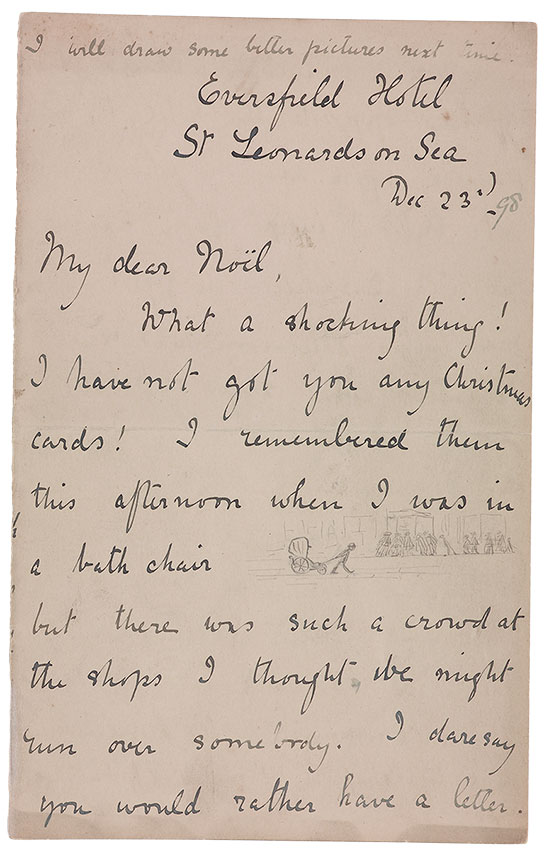
Autograph letter signed, St. Leonards on Sea, to Noel Moore, December 23, 1898
Gift of Colonel David McC. McKell, 1959
Here is another account of a seaside holiday, somewhat more sophisticated in style and content because Noel was six years older at that time. Potter knew how to calibrate her prose for an intended age group, an essential skill for an author of children's books. In this case, she understood that a boy at his age might like to learn about ocean liners and the technicalities of recovering a lightship cast adrift. She apologized for her pictures, but they were no longer quite so necessary for reading comprehension, and they include two comic sketches perfectly suited for his sense of humor. No doubt he relished the idea of a man-eating, twenty-foot conger eel, but that is a fish story. Even the most formidable specimens do not grow larger than ten feet long.
I will draw some better pictures next time.
My dear Noël,
What a shocking thing! I have not got you any Christmas cards! I remembered them this afternoon when I was in a bath chair but there was such a crowd at the shops I thought we might run over somebody. I daresay you would rather have a letter.
December 23, 1898, page 2–3
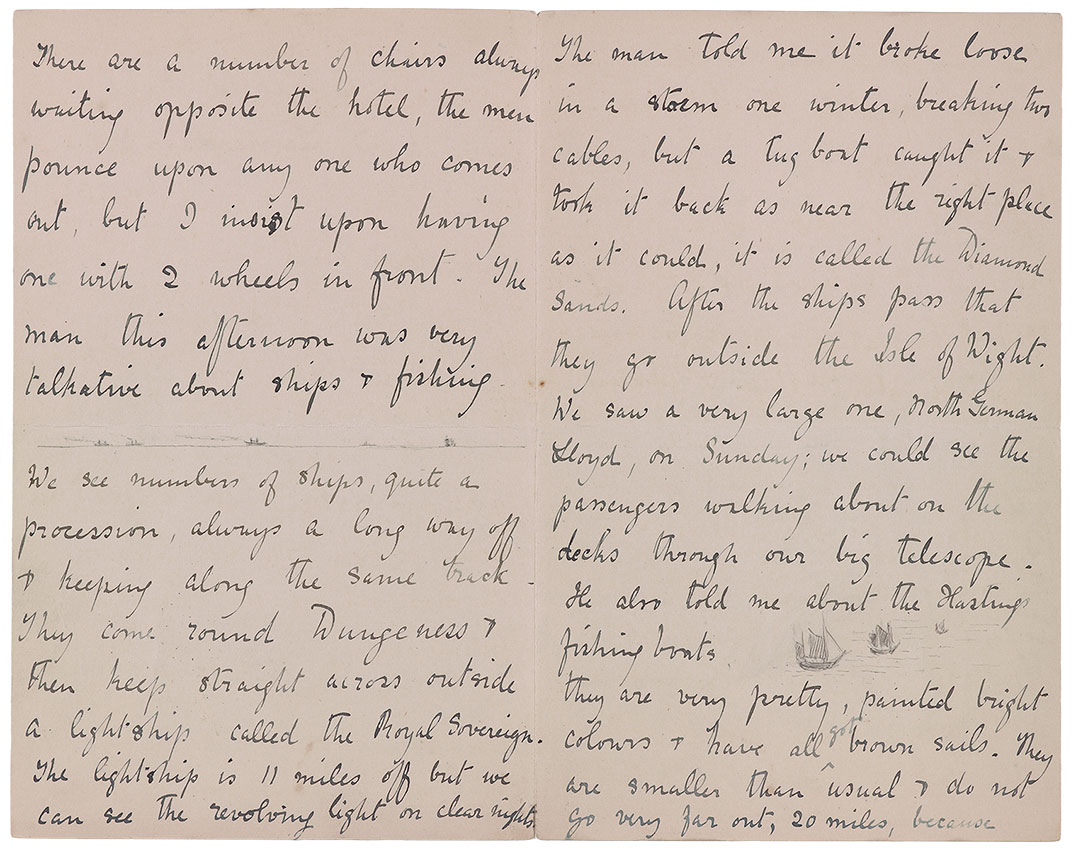
Autograph letter signed, St. Leonards on Sea, to Noel Moore, December 23, 1898
Gift of Colonel David McC. McKell, 1959
Here is another account of a seaside holiday, somewhat more sophisticated in style and content because Noel was six years older at that time. Potter knew how to calibrate her prose for an intended age group, an essential skill for an author of children's books. In this case, she understood that a boy at his age might like to learn about ocean liners and the technicalities of recovering a lightship cast adrift. She apologized for her pictures, but they were no longer quite so necessary for reading comprehension, and they include two comic sketches perfectly suited for his sense of humor. No doubt he relished the idea of a man-eating, twenty-foot conger eel, but that is a fish story. Even the most formidable specimens do not grow larger than ten feet long.
There are a number of chairs always waiting opposite the hotel, the men pounce upon any one who comes out, but I insist upon having one with 2 wheels in front. The man this afternoon was very talkative about ships & fishing.
We see numbers of ships, quite a procession, always a long way off & keeping along the same track. They come round Dungeness & then keep straight across outside a lightship called the Royal Sovereign. The lightship is 11 miles off but we can see the revolving light on clear nights.
The man told me it broke loose in a storm one winter, breaking two cables, but a tug boat caught it & took it back as near the right place as it could, it is called the Diamond Sands. After the ships pass that they go outside the Isle of Wight. We saw a very large one, North German Lloyd, on Sunday; we could see the passengers walking about on the docks through our big telescope.
He also told me about the Hastings fishing boats. They are very pretty, painted bright colours & have all got brown sails. They are smaller than usual & do not go very far out, 20 miles, because
December 23, 1898, page 4
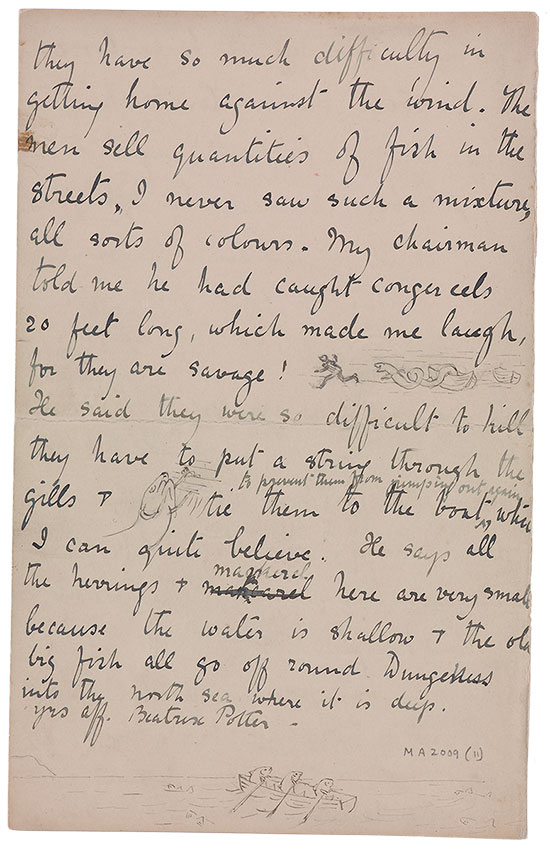
Autograph letter signed, St. Leonards on Sea, to Noel Moore, December 23, 1898
Gift of Colonel David McC. McKell, 1959
Here is another account of a seaside holiday, somewhat more sophisticated in style and content because Noel was six years older at that time. Potter knew how to calibrate her prose for an intended age group, an essential skill for an author of children's books. In this case, she understood that a boy at his age might like to learn about ocean liners and the technicalities of recovering a lightship cast adrift. She apologized for her pictures, but they were no longer quite so necessary for reading comprehension, and they include two comic sketches perfectly suited for his sense of humor. No doubt he relished the idea of a man-eating, twenty-foot conger eel, but that is a fish story. Even the most formidable specimens do not grow larger than ten feet long.
they have so much difficulty in getting home against the wind. The men sell quantities of fish in the streets, I never saw such a mixture, all sorts of colours. My chairman told me he had caught conger eels 20 feet long, which made me laugh, for they are savage!
He said they were so difficult to kill they have to put a string through the gills & tie them to the boat to prevent them from jumping out again, which I can quite believe. He says all the herrings & mackerel here are very small because the water is shallow & the old big fish all go off round Dungeness into the North Sea, where it is deep.
yrs aff.
Beatrix Potter
March 13, 1900 page 1
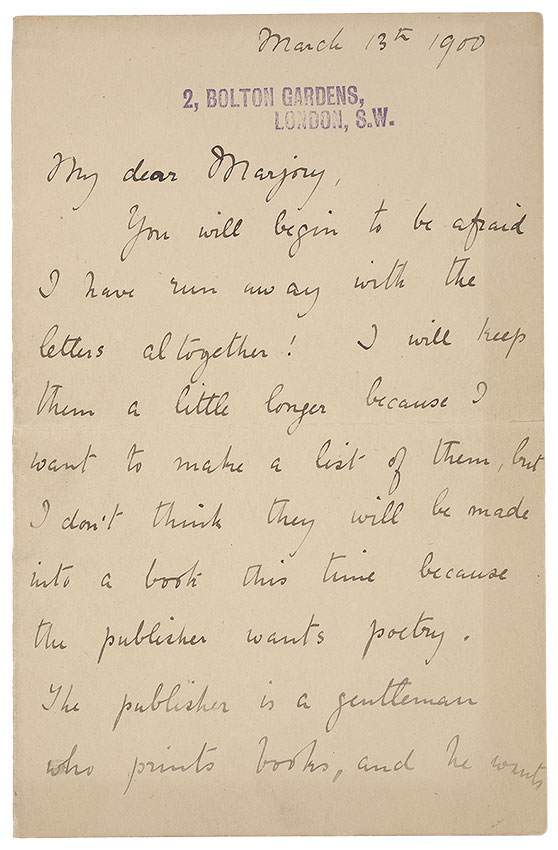
Autograph letter, London, to Marjorie Moore, March 13, 1900
Gift of Colonel David McC. McKell, 1959
Around 1900 Potter began to explore the possibility of making commercial publications out of the stories she had written in her picture letters. She borrowed them back from the children and decided to start with Peter Rabbit. Eight pages long, each episode accompanied with an illustration, that letter most obviously had the makings of a book. (The original is now on deposit at the Victoria & Albert Museum.) The publication process was frustrating and arduous, partly because publishers did not understand what she was trying to achieve and partly because she disagreed with them about publishing techniques. Here she confided to a younger sister of Noel Moore that negotiations were not going well and that she might have to try again with another firm. One of the sticking points was the price and size of the book, the publisher arguing for a larger and more expensive product, the author demanding something smaller and cheaper, a booklet "little rabbits" could afford. Eventually she got her way and succeeded in setting modest prices for a book in a smaller format, an endearing feature of the Peter Rabbit series to this day.
My dear Marjory,
You will begin to be afraid I have run away with the letters altogether! I will keep them a little longer because I want to make a list of them, but I don't think they will be made into a book this time because the publisher wants poetry. The publisher is a gentleman who prints books, and he wants
March 13, 1900, page 2–3
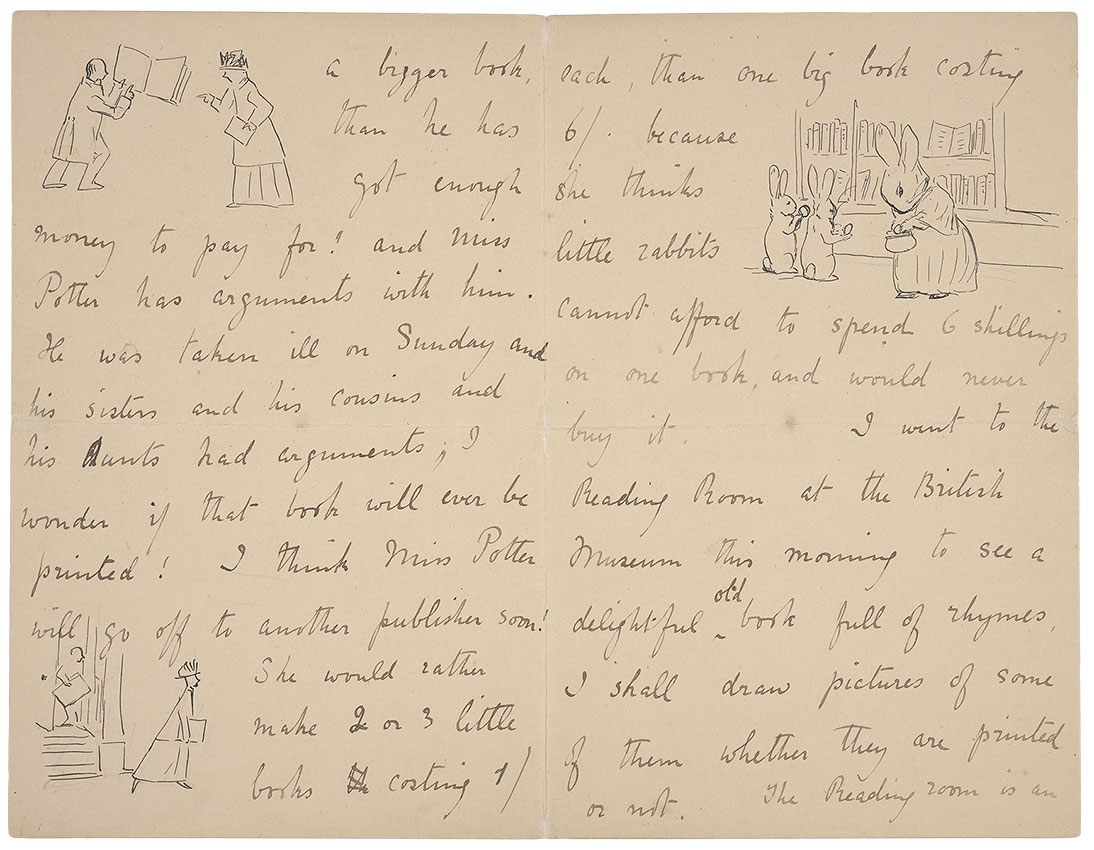
Autograph letter, London, to Marjorie Moore, March 13, 1900
Gift of Colonel David McC. McKell, 1959
Around 1900 Potter began to explore the possibility of making commercial publications out of the stories she had written in her picture letters. She borrowed them back from the children and decided to start with Peter Rabbit. Eight pages long, each episode accompanied with an illustration, that letter most obviously had the makings of a book. (The original is now on deposit at the Victoria & Albert Museum.) The publication process was frustrating and arduous, partly because publishers did not understand what she was trying to achieve and partly because she disagreed with them about publishing techniques. Here she confided to a younger sister of Noel Moore that negotiations were not going well and that she might have to try again with another firm. One of the sticking points was the price and size of the book, the publisher arguing for a larger and more expensive product, the author demanding something smaller and cheaper, a booklet "little rabbits" could afford. Eventually she got her way and succeeded in setting modest prices for a book in a smaller format, an endearing feature of the Peter Rabbit series to this day.
a bigger book than he has got enough money to pay for! and Miss Potter has arguments with him. He was taken ill on Sunday and his sisters and his cousins and his aunts had arguments; I wonder if that book will ever be printed! I think Miss Potter will go off to another publisher soon! She would rather make 2 or 3 little books costing 1/ each, than one big book costing 6/ because she thinks little rabbits cannot afford to spend 6 shillings on one book, and would never buy it.
I went to the Reading Room at the British Museum this morning to see a delightful old book full of rhymes. I shall draw pictures of some of them whether they are printed or not. The Reading Room is an
March 13, 1900, page 4
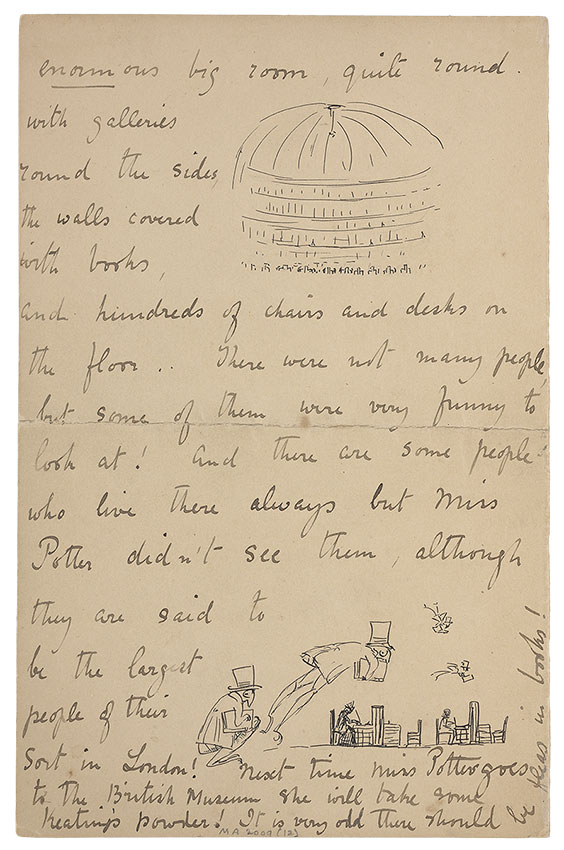
Autograph letter, London, to Marjorie Moore, March 13, 1900
Gift of Colonel David McC. McKell, 1959
Around 1900 Potter began to explore the possibility of making commercial publications out of the stories she had written in her picture letters. She borrowed them back from the children and decided to start with Peter Rabbit. Eight pages long, each episode accompanied with an illustration, that letter most obviously had the makings of a book. (The original is now on deposit at the Victoria & Albert Museum.) The publication process was frustrating and arduous, partly because publishers did not understand what she was trying to achieve and partly because she disagreed with them about publishing techniques. Here she confided to a younger sister of Noel Moore that negotiations were not going well and that she might have to try again with another firm. One of the sticking points was the price and size of the book, the publisher arguing for a larger and more expensive product, the author demanding something smaller and cheaper, a booklet "little rabbits" could afford. Eventually she got her way and succeeded in setting modest prices for a book in a smaller format, an endearing feature of the Peter Rabbit series to this day.
enormous big room, quite round, with galleries round the sides, the walls covered with books, and hundreds of chairs and desks on the floor. There were not many people, but some of them were very funny to look at! And there are some people who live there always but Miss Potter didn't see them, although they are said to be the largest people of their sort in London! Next time Miss Potter goes to the British Museum she will take some Keating's powder. It is very odd that there should be fleas in books!